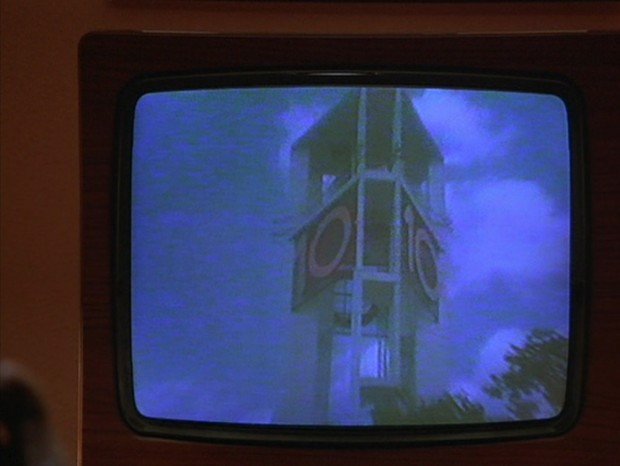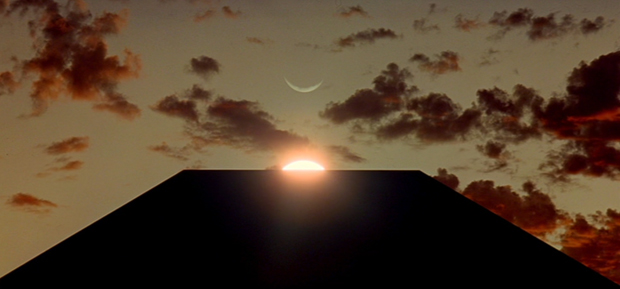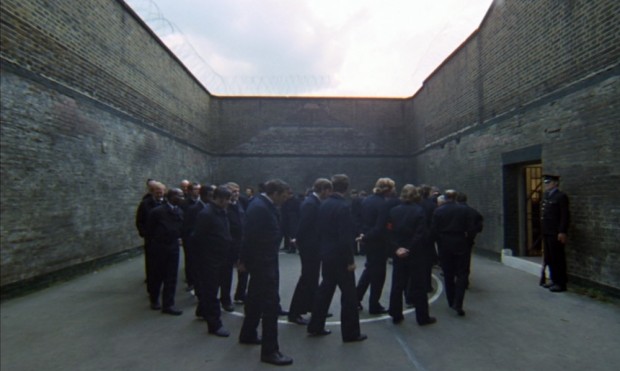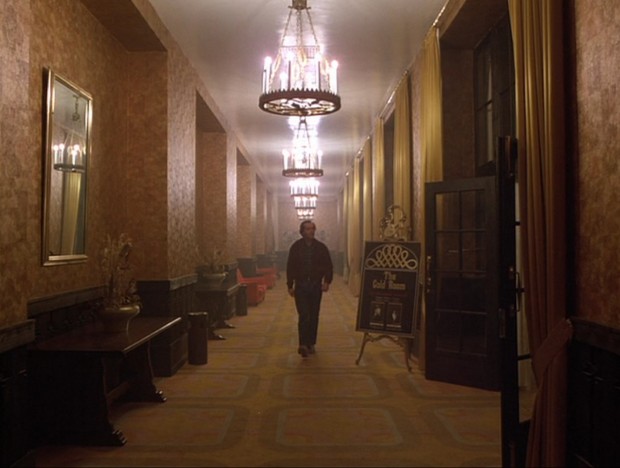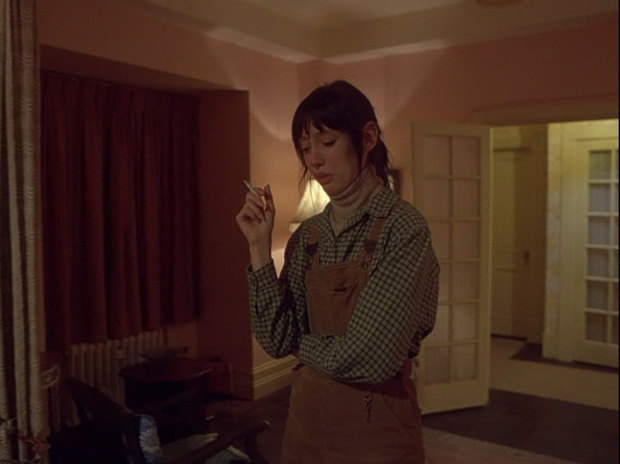STANLEY KUBRICK'S THE SHINING

Go to TOC for this film ( (which has also a statement on purpose and manner of analysis and a disclaimer as to caveat emptor and my knowing anything authoritatively, which I do not, but I do try to not know earnestly, with some discretion, and considerable thought).
WEDNESDAY (PART TWO)
The revenge of Janet Leigh
TOC and Supplemental Posts | Part 1 - The First Ascent | Part 2 - The Interview | Part 3 - Closing Day |
Part 4 - A Month Later | Part 5 - Tuesday | Part 6 - Thursday | Part 7 - Saturday | Part 8 - Monday |
Part 9 - Wednesday Part One | Part 10 - Wednesday Part Two | Part 11 - 8 AM | Part 12 - 4 PM |
Films Home
LINKS TO SECTIONS OF THE ANALYSIS ON THIS PAGE:
The Three Perspectives of Dick, Danny, and Jack, 300 through 328
Dick, in Miami, is brought into the situation. Ground zero and the trapezoidal pyramids.
Comparisons with Eyes Wide Shut, its Maze, the Hedge Maze at Somerton, 237 as the Verona Restaurant. 236 and the hospital. ZKR. The themes of re-education (correction) in Full Metal Jacket, A Clockwork Orange, and The Shining, and the mystery of free will or predetermination.
Room 237. Its television and carpet. 2001 and Room 237. Resemblance of the bathroom to other rooms in the film. Beldam as the crone, and bedlam, an insane person.
Jack in Dick's Miami Home, Shot 329
Other links between the Miami home and the lodge.
There is Nothing in Room 237, Shots 330 through 339
Jack has seen nothing. Danny forsees Redrum which he will himself later write. A permutation of nothing, AIN, into a confrontation with self, ANI.
The Masquerade, Shots 345 through 346
Dick Calls the Forest Rangers, Shots 347 through 350
Good Evening, Mr. Torrance, Shots 351 through 367
Hell, Shots 368 through 389
The red bathroom. Comparing the Gold Room and Red Bathroom to the lobby.
About that Frank Lloyd Wright Inspired Bathroom
The Gold Room and the Arizona Biltmore
The Two Gradys, Charles and Delbert
Danny's Not There, Shots 390 through 397
Jack Unplugs, Shots 398 through 401
Fire Service, Shots 402 through 404
In Review, What Has Kubrick Given Us in This Section?
What's the teaser candy bait?
What's the distraction?
What's the food for thought?
What's the deep infrastructure?
THE THREE PERSPECTIONS OF DICK, DANNY, AND JACK
DICK, IN MIAMI, IS BROUGHT INTO THE SITUATION - GROUND ZERO AND THE TRAPEZOIDAL PYRAMIDS
300 CU television. (1:09:48)
Cut to a blank screen, a flash of blue then a series of images all in washed out blues and greens and faded purple-reds--and by washed out I mean this is a land of diluvian blues. First we see large buildings (hotels) on a sea shore. That image is then split in two by a plane ascending (much like the rocket on Danny's Apollo sweater) so there are three panels of image. In the left panel there now appear two women walking, the plane continuing to ascend in the center, a couple of sailcrafts viewed in the right panel. This is followed by a brief full screen image of a boat. Then an image of an ocean breaker with two tracks on it, the rocky breaker curving left into the ocean, abruptly ending, and beyond it several boats. The camera has begun zooming out, showing us we are watching a television screen. There is an image of a lighthouse quickly crossfading to a (in respect of the lighthouse) giant of a worker (migrant?) laboring in a field.
Earlier in the film we'd had Jack as the giant looming over Wendy and Danny as they ran out to play in the maze, Jack as the giant as he looked over the miniature maze, watching Danny and Wendy within it, Wendy as the giant looming over the mountain while opening the giant can of fruit cocktail, then Danny as the giant looming over his toys in the hall outside Room 237, and the camera having a superior view over him. The seeming giant laboring in the field beside the lighthouse seems a correspondence.
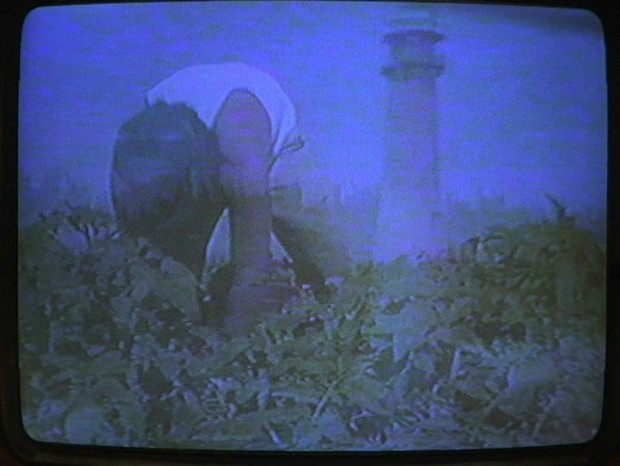
Fig. 1 - Crossfade from the lighthouse to the "giant" worker in the field.
NEWSCAST: From Channel 10 in Miami, this is Newswatch, with Glenn Rinker, Ann Bishop, and the award-winning Newswatch team.
Coincidental, when I hear the name "Ann Bishop", I realize the lighthouse looks a little like the Bishop piece in a game of chess. Bishop means high priest, in the Old English, from the Greek episkopos, meaning a watcher or overseer. The Bishop chess piece used to be the archer. Only noting it as Kubrick was a chess person.
This is a real anchor team. No made up names. Just thought that fun to throw in because of chess.
The lighthouse. In A Clockwork Orange, the song, "I want to marry a lighthouse keeper" accompanied Alex's parents reading the newspapers when he returned from his Ludovico treatment. Ideas in the song seemed to complement articles in the paper, such as one concerning a yachtsman, and a "wedding scandal" headline. It's interesting to me that we have the lighthouse paired with news again.
Cut to a child in a striped shirt in a stroller waving American flags. Throughout the film we've had the American Flag always paired with either the Colorado flag or maps of Colorado, but now we instead have a pair of American flags. Cut to a red flashing police light on a car with two officers standing beyond, one turning to look back at the camera, and a Panamerican plane beyond them.
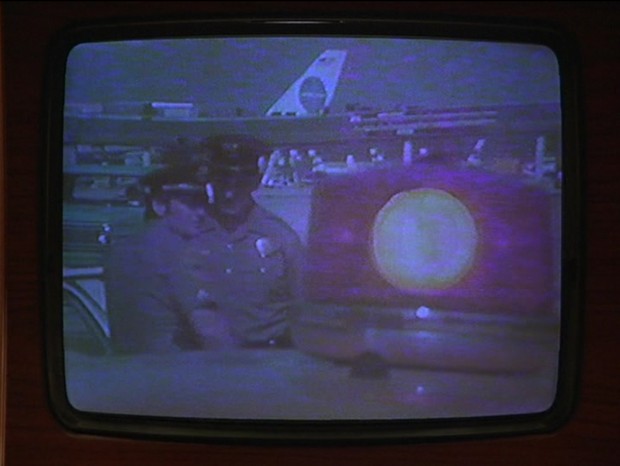
Fig. 2 - The police and the Panam Jet.
Next two kids descending from a school bus. We see the news station's tower with the number 10.
You can barely make out the third 10 behind and between the two 10's of the tower. All that we see of it is 0.
Eyes Wide Shut made use of the number 10 a good bit. The Rainbow shop's address is 10 the first day Bill visits it and then when he visits it the second time we see instead two 10's, one on the facade of the building and another that's been added on the building's door. The 10 on the door wasn't there the previous night.
These 10s at the Rainbow in Eyes Wide Shut, and the lighthouse in A Clockwork Orange, happen at a kind of dividing line in the film. Alex has returned home to find his parents have acquired a new lodger who has replaced him. Homeless, he now finds himself revisiting characters and scenes from the first part of the film. He meets the old drunk he abused. His droogs have become police. He accidentally finds his way back to the HOME of Alexander. As for Bill, we have the 10 duplicated on the Rainbow when he is now returning to places he had visited the night before. Like Alex, he retraces his own footsteps, only he does so intentionally. But both those films had actions to retrace. We've actually had very little action thus far in this film. The first half was spent largely tied up with visions of the assumed Grady girls. Jack pitched a fit. He had a nightmare. Wendy has been working on her own in the kitchen, tending the boilers, playing a little with Danny. That's about it. We've explored the hotel. The way the film is set up it's been about the audience waiting for certain anticipated events to unfold. We're now at a kind of dividing line and about to enter Room 237.
Follow the television station's 10/10 with a busy news room. Hands at typewriter keys, reminding of Jack at his typewriter. Dissolve to the control area of the news room with individuals watching numerous monitors as the camera continues zooming back so we now see Dick Hallorann's feet, we watching the television from his perspective. It's a television news report from Channel 10 in Miami.
The numerous television monitors can be kind of looked at as a joke, because the television that Dick is watching is the same as in the Boulder apartment, and we will later see that this same television is in suite 3 at the Overlook.
Dick, by the way, did not cut on the television. The television cut itself on.
And, before we go any further. Yes, there were television remote controls back in 1980 but, no, Dick, as we shall soon see, is not holding one, and yet the television has just cut on. Kubrick showed it cutting on, showed the black screen first and then the flicker of the television cutting on. This reminds us of Wendy and Danny watching a television without a cord.
Dick did not cut on the television, yet it has cut on and he looks at it as if everything is normal.
Cut to Glenn Rinker at WPLG reporting that while they're having a sweltering winter heat wave with temps in the 90s, the central and Rocky Mountain states are buried in snow. Kubrick's camera continues to draw back, showing lamps placed symmetrically to either side of the television, a picture of a topless woman with a large Afro on the wall above the television. "In Colorado, 10 inches of snow has fallen in just a few hours tonight. Travel in the Rockies is almost impossible."
In this film, Kubrick has a lot of television serving as backdrop for scenes. There was the Carson City movie that played while Danny was shining in the bathroom, the newscast that played just before Danny tried the door to Room 237, and the Summer of 42 movie that played prior Danny's conversation with his father in suite 3.
The image of the woman facing Dick is a poster of Azizi Johari titled "Supernatural Dream". It reminds of the suggestive female form in the photo above Bill Watson's head on Interview day when Stuart was telling Jack about the murder at the hotel and how he found it hard to believe it had happened there, this followed by Danny's vision in the bathroom.

Fig. 5 - Dick watching Miami's Channel 10 news.
GLENN RINKER: Good evening, I'm Glenn Rinker, Newswatch 10. While Miami continues to swelter in a record winter heat wave, bringing temperatures to the mid and upper 90's, the central and Rocky Mountain states are buried in snow. In Colorado, 10 inches of snow has fallen in just a few hours tonight. Travel in the Rockies is almost impossible.
301 CU Dick. (1:10:21)
GLENN RINKER: Airports are shut down, stranding 1000s of passengers. Highways are blocked by snow drifts. Railroad tracks are frozen. Officials in Colorado tell Newswatch at least 3 people have been killed by exposure to freezing winds. The governor of Colorado's expected tomorrow to declare a weather emergency. The national guard might be called out to clear streets and roads. Weather forecasters predict more snow, and heavy winds tonight and tomorrow. With temperatures dropping well below zero.
Oppositional close-up now of Dick's face. The camera zooms out and shows another painted picture of a nude woman against a red background above his bed. We have the same pair of lamps as to either side of the other poster but these are positioned so a red side dominates, whereas the others are positioned so a blue side dominates. The lamps have turned, just as we can look upon the two posters as representing the woman having turned 90 degrees. Just as we have the lamps having turned 90 degrees.
The rays of light from the twin lamps create a shadow trapezoid/triangle shape that leads up to the woman so its apex appears to be located on her face, in the middle of the afro.

Fig. 5 - Dick from an opposing angle.
This recalls the ch O king poster with the red trapezoid/triangle topped by the large O, the circle.

Fig. 6 - The choking poster with its circle at the top of the trapezoid/pyramid.
It is much the same thing as the monolith with the supposed sun peaking over its top. If one examines when these convergences occur in 2001, they are not "real" occurrences. They are impossible. They appear in the film as ideas.
This echos the pyramid behind Jack on Tuesday, formed by shadows of the two lights of the wall sconce radiating down the wall, with the brilliant illumination above as the obscured vanishing point/angle of convergence.

Pyramid and pyramidal trapezoid, monolith, vanishing point and single point perspective, all wrapped up in one in the corner of a page,but the apex (and, hence, the vanishing point, the pyramid, the angle of convergence) is obscured.

The corner page as a shadow and the trapezoidal pyramid behind Jack.
These are glyphs that appear over and over again in Kubrick's work. Ideas represented in a picture.

Fig. 11 - Pyramid and pyramidal trapezoid, monolith, vanishing point and single point perspective, all wrapped up in one.

Fig. 12 - Pyramid and pyramidal trapezoid, monolith, vanishing point and single point perspective, all wrapped up in one, but the apex (and, hence, the vanishing point, the pyramid, the angle of convergence) is obscured.
We have a similar obvious pairing of the circle and triangle in A Clockwork Orange.
The circle is below the triangle in the exercise yard--but what happens while the prisoners are exercising? In Alex's cell we see this.

The parallel lines of the train track become a triangle (just as does the monolith when viewed at an angle), and the circle on the front of the train could be taken as representing the vanishing point.
I noted that the television in Dick's room is the same one as in the Boulder apartment. What is opposite the television in the Boulder apartment?
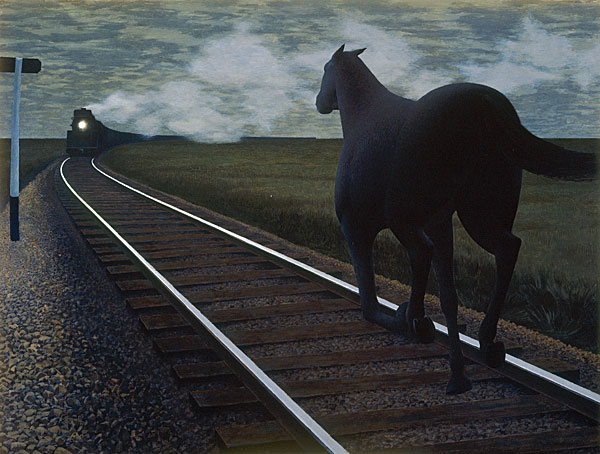
On the television set in Boulder the movie that was played had to do with the drilling of a railroad tunnel through a mountain. The tunnel is drilled from opposite ends and meets at the middle. Opposite this, there is the painting of the horse racing down the railroad track. In the bathroom, Danny is having his first shining of the elevators, the girls, the blood.
In A Clockwork Orange, the idea of the resurrection of the past through cinematography is the crux of Ludovico treatment. He will watch films in which he sees first what appears to be real life, blood looking even more real on the screen than in real life, and then he will watch films of Nazi Germany. Afterward, every time he hears the music that was playing during those viewings, the nausea that was inspired by the drugs he was given is resurrected. He has been programmed to become ill.
In Boulder, this television was opposite the painting of the horse while Danny was having his first vision. Now Dick is about to have his vision, and the same television is opposite a painting, above his head, that represents much the same thing as in the railroad painting, as in the image of the comic from A Clockwork Orange. Something is about to be resurrected. An anamnesis.
I've discussed how Kubrick has positioned the lodge at a kind of 0 point, the Continental Divide, and I think in EWS that Kubrick positions Bill at a kind of 0 point in Greenwich, as in the 0 point for the Greenwich time line. We see this in the world maze that Jack (or the audience) viewed, that took the place of the maze in the lobby. A partner idea seems to me be an expression of the Primal Point, Resheit, the beginning. "Beyond this point, nothing is known," as the Zohar says. With the pairing of lamps, illumination, to either side, one can think of it as 1-0-1. The reason I bring this up is due Kubrick choosing channel 10 as the one that will bring Dick his news, and we have a multiplicity of 10s here, just as with the Rainbow costume shop in Eyes Wide Shut, Bill having been invited to the end of the rainbow, of which the address is 10 when he first visits it, then when he returns the next day it has two 10s on its facade. I explore in my analysis of Eyes Wide Shut how this idea of the primal point, 0, is possibly seen in the choice of Greenwich village is the stage for much of the activity, a correspondence being had with Greenwich Mean Time (1-0-1, a center point had by virtue of it being absolute time). This could be compared to Kubrick's plotting of the position of the Overlook according to the Going-to-the-sun Road. Yes, the action in The Shining is all supposed to be happening in Colorado, but the film opens with the VW on the Going-to-the-Sun road in Glacier National Park. The last scene on the road during the opening, before we cut to the Overlook, places the VW traveling west and situated east of the Continental Divide. The 2nd time the VW ambles up to the Overlook, the last scene on the road before Kubrick cuts to the lodge, places the VW traveling east while being situated west of the Continental Divide. In other words, as far as the film's VW on the Going-to-the-Sun road is concerned, the Overlook is at the Continental Divide, another expression of 1-0-1, the primal point and its relationship to manifested duality and the tree of life.
How to express what I'm getting at, which is really best approached through intimations, through poetry.
First, to take an easy quote from Wikipedia:
The ten aspects of the Divine, with the relation to its precursor states of nonexistence, its self-realization stage called Tzimtzum, and their immediate manifest reflection in the top three aspects with the gap between those exalted states of being and the lower more mundane types, along with Da'at, the 11th or uncounted aspect of the divine which is a path that is forbidden, can be described as:
000. Ain (Nothing)
00. Ain Soph (Limitlessness)
0 Ain Soph Aur (Endless Light)
-.Tzimtzum (Contraction)
1. Keter (Crown)
2. Chokhmah (Wisdom)
3. Binah (Understanding)
-.Daat (Knowledge)
1. (4) Chesed or Gedulah (Loving Kindness or Mercy)
2. (5) Gevurah or Din (Power or Judgement)
3. (6) Tiferet (Beauty or Compassion)
4. (7) Netzach (Triumph or Endurance)
5. (8) Hod (Majesty or Splendor)
6. (9) Yesod (Foundation)
7. (10) Malchut (Realm)
Room 237 is certainly forbidden, as was Somerton. Daath is that path which carries individuals into imponderable revelations/confrontations concerning themselves and their universe. It was a confusing hell of a ride in 2001, it's a confusing hell of a ride in The Shining for Danny, Jack, Wendy and Dick, and it's a confusing hell of a ride for Bill in Eyes Wide Shut. There is essentially nothing pleasant in having our ideas of the world and what we esteem as natural order stripped away and being confronted with something "other".
The reporter continues. "Airports are shut down, stranding thousands of passengers, highways are blocked by snow drifts, railroad tracks are frozen. Officials in Colorado tell Newswatch at least 3 people have been killed by exposure to freezing winds. The governor of Colorado is expected tomorrow to declare a weather emergency. The National Guard might be called out to clear streets and roads. Weather forecasters predict more snow and heavy winds tonight and tomorrow, with temperatures dropping well below zero."
If we return to the hotel and take a look again at Ullman's office, we see that the warm salmon pink of Dick's bedroom walls is either identical with or close to the salmon pink of Ullman's office. Dick's bedroom is as the opposite to Ullman's office. One is summer and the other is winter.
302 MS television from Dick's POV. (1:10:50)
GLENN RINKER: Back here in south Florida, we've got just the opposite problem. The heat and humidity are supposed to climb. Local beaches should be jammed. Our weather experts (unintelligible) will have the local forecast later on Newswatch.
303 CU Dick. (1:10:55)
As Dick watches the television reporter relate local beaches should be jammed, a loud heart beat begins, mixed with music, overwhelming the newscast. Dick gazes, terrified, up at the ceiling, trembling, the camera zooming in on him.
The viewer may assume the heartbeat belongs to Dick, but does it. We've a melding of 3 experiences in the following Room 237 scene and no clear idea of who is seeing what, though it's inferred all are witnessing the same events. The heartbeat could belong to Dick, Jack, or Danny, but one might also wonder if the heart beat may instead belong to the Overlook.
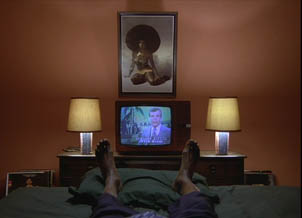 302 |
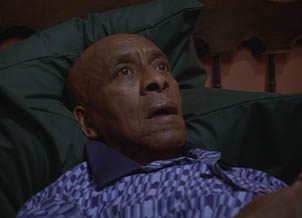 303 |
COMPARISONS WITH EYES WIDE SHUT, ITS MAZE, THE HEDGE MAZE AT SOMERTON, 237 AS THE VERONA RESTAURANT, 236 AND THE HOSPITAL, ZKR - THE THEMES OF RE-EDUCATION (CORRECTION) IN FULL METAL JACKET, A CLOCKWORK ORANGE, AND THE SHINING AND THE MYSTERY OF FREE WILL OR PREDETERMINATION
In Kubrick's films, characters are often submitted to extremes of mental violence for the supposed purpose of making them conform or saving them from some defect or action of their own. For instance, Bill's misstep in Eyes Wide Shut is his curiosity that compels him to visit Somerton though he's been told by the piano player he doesn't belong there. Yet he does belong there as he was expressly invited, as I point out in my analysis of Eyes Wide Shut.
There are many parallels between The Shining and Eyes Wide Shut. The city's streets in Eyes Wide Shut are a virtual maze in which Bill has various encounters but many occurring with the same backdrop however disguised by a different facade, new make-up on an old face. It is near Christmas, the Winter Solstice, the Festival of Lights, just as here it is the beginning of December, but bringing in Dick in Miami we take a southerly turn into Summer, just as Bill's journey takes him to Somerton (summer) where he experiences the mysterious party.
To make everything all the more interesting, Somerton is also the spot of a famous troy maze in England.
When Bill revisits the situations of the previous night at Somerton, he finally realizes he's being watched as he passes a building numbered 37 and sees a bald man following him passing a building numbered 23. As Bill becomes increasingly fearful he stops before a restaurant with the address 237, which we will momentarily see is the Verona Restaurant. He waves for a cab but is unable to hail one. He crosses the street and takes refuge before a news kiosk, the bald man now distinctly threatening, there being no doubt he's been following Bill, the Verona Restaurant to his rear as he gazes up the street directly at Bill. Bill picks up a paper that reads "Lucky to Be Alive." We will shortly find inside it a story on the "beauty queen" (a prostitute) who has overdosed and that no foul play was suspected. Alongside that story is one on a hostage situation on a train that ends with text on the harm of mental violence. There are other linking elements but these are some of the main ones, the idea of mental violence being primary.
Verona comes from Veronica and has taken on the folk meaning "true image", Veronica being supposedly the woman who, when he was on his way to his crucifixion, wiped the face of Christ with her veil, thus recording his true image, becoming an icon of him. Of course, wherever there is the idea of a true image, there is also the idea of a false one.
It's after this brush with 237 that Bill goes to the hospital, finds that Amanda has died, and visits the body of the beauty queen/hooker in the morgue. When Bill arrives at the hospital, we can see out the doors on an opposite wall the street number 236, so either this is the street number of the hospital, or it is the number of a place just opposite ( it's difficult to tell if this is a real street or a drive-thru for the hospital), but either way The Shining is referenced again as it was the door to room 236 that was discreetly open when Danny tried to enter Room 237 on Tuesday.
Bill Harford is later told that he was indeed followed, in order to frighten him, but that his interpretation of the situation is wrong, that the prostitute, who had taken a Christ-like redemptive posture in the story, wasn't murdered as Bill believes her to have been. In Eyes Wide Shut, as in The Shining, we have characters operating in mazes in which all is not as it seems to be--neither for the characters nor the audience, and though it's difficult to impossible for the audience to come to a certain conclusion as to what is true and what is false, Bill, at the end, in his conversation with Alice, asserts that he considers himself lucky to be alive, as if he has survived a very dangerous journey indeed.
Ideas concerning zeker, remembrance, being not only past experience but coming alive in the present--such as in the idea of anamnesis, of the Passover and the deliverance from bondage as being a real experience to be had by each individual, and in the eucharist not being only a memorial event but a remembrance that is a real occurrence--I think are expressed in the film in conjunction with 237, and have written on it here.
In Eyes Wide Shut, the mystery was whether what Bill has experienced was real or an elaborate charade put together in order to teach him a lesson. And even if it were an elaborate charade, what of the coincidental death of the woman who stepped forward to redeem him? Has the charade become real life? Due the mask she was wearing at the orgy, and the alterations death has brought to her face, when Bill examines the woman he is unable to tell if she was the one at the party. The Verona (true image) Restaurant as 237 (gematria for ZKRI, a version of ZKR) anticipates this examination, looking for the true image, trying to discern who she is--and though in The Shining we've a quite different situation, again, Jack will divine in the mirror of Room 237 an alternate image of the young woman who rose from the tub, a type of crypt, to embrace him, and that rather than being young she is old and decaying. Or she is actually old and young all at once, for form changes from moment to moment. An infant is quite different from the individual they are many decades hence, different in appearance from the aged person on their death bed, and yet all are the same person.
But, of course, Bill throughout Eyes Wide Shut is not only attempting to separate fact from fiction in his world, but what is his true self as versus his crafted persona, and the same for his wife.
As previously stated, in Kubrick's films, characters are often submitted to extremes of mental violence for the supposed purpose of making them conform or saving them from some defect or action of their own, the question being whether this is ever justified, and are actions free will or a clockwork predetermination.
Bill's seeming misstep was the curiosity that compelled him to visit Somerton. It's the attraction of the forbidden, and the prospect of seeing women the pianist describes as the like he's never seen elsewhere. He made a grab for the password that would get him into what he believed was a party, but it was also one that fell in his lap, as if predetermined to do so. So too with Danny's entry into Room 237. He was warned to not go in it but then he received a personally engraved invitation with the lure of the yellow ball that his father had been slamming around the lodge.
In Full Metal Jacket the characters are re-educated in the Marines, suffering mental violence for the supposed sake of their own survival, even though they are told that should they be killed in the war their deaths as individuals will not matter. Here, Danny and Wendy will be increasingly depicted as needing re-education for the hotel's sake. The American flag is seen again and again in the film, the white man's burden has just been referred to, the right to the forcible education of those considered heathen and living in the dark, of those who have not subjected themselves to the right rule. In The Shining the servants have the great responsibility of keeping the world of their Betters in good working order, which means quelling all protest in themselves and others.
In the newscast Dick watches as he begins his shining, the child in the stroller may represent Danny, linked here with with the police lights, the school bus, Danny threatened by his former schoolteacher father. When Jack was finally relating his story of what had happened to Danny, how he had dislocated his shoulder, it was over Danny having strewn some of Jack's school papers on the floor, Danny just having entered preschool himself. For Jack, that the papers were strewn about the floor suggested a disregard for them, and for him. Even if not an intentional rebellion, Danny has a lack of comprehension for ideas vital to Jack's concept of self and his place in the universe, and so at the Overlook we have Jack, the former schoolteacher, greatly concerned with Danny's "education", with ensuring Danny conforms to his own ideals and desires, ideals and desires that are shared by the lodge.
In Clockwork Orange a lighthouse is referenced via the song "I want to marry a lighthouse keeper" which plays after Alex has undergone the mental violence of his Ludovico rehabilitation, his re-education, so that every time images of violence come to mind, or he hears Beethoven, he becomes violently ill. After his successful re-education into the "perfect Christian", he returns home to find his parents have taken in a lodger who occupies his room, this lodger treated by his parents much like their new surrogate son. "I Want to Marry a Lighthouse Keeper" plays at the beginning of this scene as we view images of the different newspapers being read by his father, his mother, and the lodger, all of them with a report on the Cat Woman murderer who's been released, which is Alex. Earlier in the film, the Cat Woman was directly associated with the sphinx, her front stoop on which Alex was temporarily blinded flanked by a pair of them. Her house was full of cats, as well as paintings that functioned much as the television does in The Shining, presenting commentary on the action, images that depict symbolically both Alex's past and future, a place of oracle. The cat woman (sphinx) killed, an Oedipal twist enters with the surrogate son of Alex's parents even represented as a sort of surrogate husband to the infantile mother. Without a home, in exile, Alex takes to the street and is thus doomed to revisit former situations. Rehabilitated, he is helpless to defend himself even as vengeance is carried out upon him for his former deeds. Finally, he finds his way to the lights of HOME, where Kubrick further confuses Alex's identity by having him become a sort of surrogate son and mirror of Alexander, the author he'd earlier perversely beaten and whose wife he'd raped. Alexander is ultimately linked to Anthony Burgess himself, as if Burgess is the god, identified by Kubrick, as responsible for Alex. Alex had raped Alexander's wife so an Oedipal twist enters also here, and Alexander is concerned with Alex's re-education, first for philosophical and political purposes and then for revenge, just as Jack is determined to "correct" Danny and Wendy.
And, all the while, the preoccupation is the real Oedipal concern and question concerning what is mechanical destiny and what is free will? That is a thread which runs through all these films.
ROOM 237, ITS TELEVISION AND CARPET - 2001 AND ROOM 237 - RESEMBLANCES OF THE BATHROOM TO OTHER ROOMS IN THE FILM - BELDAM AS THE CRONE, AND BEDLAM, AN INSANE PERSON
304 Open door of Room 237. (1:12:37)
Cut to Room 237. This framing of the open door now highlights the idea of the "double door", that it is two doors and could possibly lead to two different versions of the same room.
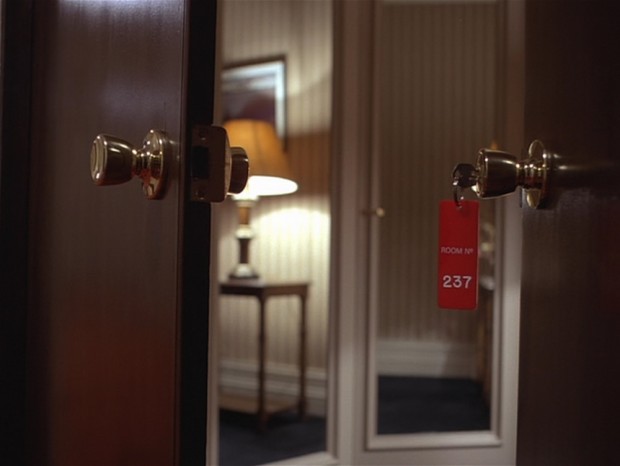
Fig. 13 - Approaching Room 237 again.
305 MCU Danny. (1:11:39)
Cut to Danny in his bed in the Torrance's suite, in red pajamas that are a version of the two red union suits Wendy wore the day of the interview. Deep in a trance state, he shakes uncontrollably, drool streaming from his lips.
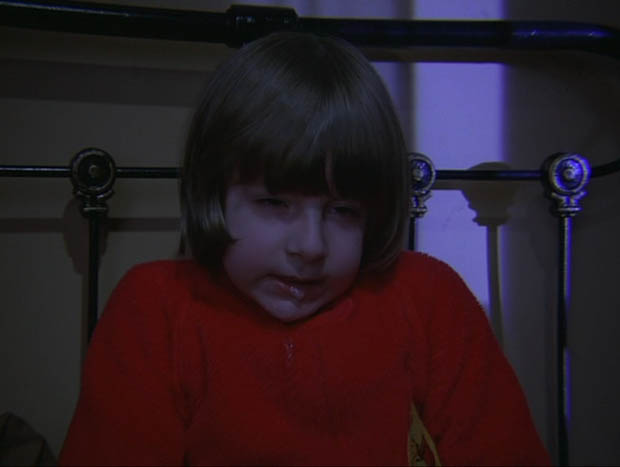
306 MS living room of Room 237. (1:11:47)
Cut to Room 237 again with its bright 1970s version of Disco Art Deco design, purple seating, green and purple carpet, a fireplace, gold and white or beige and white striped wallpaper. Elaborate and pricey. Gaudy and tasteless. The effect is chaotic.

Fig. 14 - The sitting area of Room 237. It shares the same television as the lobby.
There is a television in Room 237, its cabinet doors closed. It appears to be the same make of television as observed in the lobby upon which Wendy was watching Summer of 42 when Danny left to get his fire truck from the suite and heard in his father's speech the same fatal prognostication of "forever and ever and ever" that served either as an invitation, or a warning, or perhaps both, from the Grady girls.
The camera (Jack's POV) scans the fancy sitting room then is attracted to the ajar bathroom door and the green walls within, a green to be compared with that which we'd seen in the stairwell near the elevators.
The design elements of Room 237 are unlike what one would expect for the hotel, the materials eccentric as in they are out of place, a wild mix of sedate and bold prints, the carpet nearly raucous and as startlingly bold as the carpet in the hall outside.
The carpet's concentric arcs remind of the rainbow on Danny's door that had introduced us to the bathroom across the hall from his room. The colors in the carpet mimic the colors we'd seen in Dick's television in Miami, a mix of green, blue-green and purple.
Just as the Newswatch lighthouse image had preceded the rotating light of the police cruiser, the purple in the green arcs has an electric pulsating quality. Though it seems phallic in shape, the rainbow arcs pull into the carpet the paintings of the women in Dick's home, their heads haloed by large afros. And, just as Wendy had been in the boiler room with the nude pin-ups and the CH O KING poster, while Danny was supposedly being strangled in Room 237's bathroom, here we have the nude images of the women in Dick's room as he "shines" Room 237 in which Jack will face the nude trickster.
Whereas the design of the carpet in the hall both pushes and pulls, going in two directions at once, the repetitive wave-like motifs in this carpet compel in only one direction, toward the bathroom.
Ka-bump, ka-bump, ka-bump goes the accompanying heartbeat, and we've a sense of presence to Room 237 that links it to 2001 and the bathroom of the baroque bedroom in which David Bowman sees older versions of himself which he becomes, just as we will soon have the phantasm of a woman morphing from young to old. The ancient Bowman who sees the monolith as he lies in his bed--that which had nudged the ape men toward a seeming higher consciousness--could perhaps be compared with Dick in bed and his visionary state. It is as if the rooms, as with the monolith, are themselves alive and conscious or at least expressive of a weird intentionality, aware and waiting, just as a chair in the opening of Lolita becomes enlivened with the enigmatic Clare Quilty morphing out of it and rising--Quilty, a man of many disguises, frequently disturbing Humbert Humbert's life without Humbert ever realizing these harassing persons--who appeared at pivotal points, each one threatening to Humbert with their insinuating awareness of his criminal secret--were all the same individual. Quilty's appearance always marked a dramatic change in the proceedings. When confronted with Humbert in his own home, Quilty sarcastically asks if he's Spartacus there to free the slaves, which is yes a simple reference to another of Kubrick's films but speaks also to the function of the monolith as an evolutionary doorway through which one makes progressive steps away from bondage, such as the ape man's slavery to helpless fear. Each of Kubrick's films is concerned with the idea of whether or not the slavery of self, of society, of violence, of mechanical predetermination can be escaped.
In King's The Shining, Jack only senses but doesn't directly encounter anything in the bathroom where an older woman, abandoned by her young lover, committed suicide.
In the book, a chapter was devoted to Danny finding the corpse of the old woman in the tub, which became animated but didn't strangle him. And Jack, upon going to the room, didn't observe anything directly, seeing neither an old woman nor a young one. Instead, after having looked in the tub and finding nothing, he discovered the shower curtain had been drawn shut again and thought perhaps there may be an amorphous shape behind--or perhaps it was just a trick of light.
Whereas King's phantasm had closed the curtain, Kubrick's pulls back the curtain for Jack to see what is there.
Summer of 42, not mentioned in the book, involves the encounter between a teenage boy and an older woman. Does Kubrick intimate that Jack may once have been abused? But there is also the approach had through cross-analysis with 2001, in which Bowman confronts himself growing significantly older, in each instance he being two seeming consciousnesses that become briefly aware of the existence of the other then blend together. Jack will be confronted with the apparent transformation of a young woman to a decaying elderly woman, we also seeing a reanimated corpse rising from its bathtub crypt, this initiated when Jack looks in the mirror, just as Bowman first perceived his older self in the bathroom mirror above the tub in the room at the edge of infinity.
Bathrooms have an air of the sacred to them with Kubrick. They are places of revelation where one is finally unable to escape some aspect of truth and must be confronted with it.
Continuing with this long single shot of Jack progressing toward this meeting, urged there by the carpet, we move up a short flight of stairs between the living area and the bedroom area. There is also a short flight of stairs just inside the Torrance's suite that lead up to the living area. No reason exists for them to be there as essential architectural elements and so I wonder at their symbolism, if they are perhaps an expression of Jacob's ladder, much like the stool Danny climbs upon to look into he mirror in the Boulder bathroom (though that bench is also necessary for him to reach the mirror because of his youth). As both Room 237 and Suite 3 have this architecturally unnecessary flight of steps, are these two places womehow linked?

Fig. 16 - Looking through the bedroom to the bathroom of Room 237.
To the right of the bathroom door is a print of a fox, a trickster animal. In myths of old Japan, the shapeshifting fox favors taking on the likeness of a beautiful woman.
A hand reaches out and presses the bathroom door open and though this bathroom is green and the bathroom in their apartment in Boulder had been pink, Room 237's bathtub with its shower curtain, the way it is lit, recalls the scene of Danny speaking to Tony before the bathroom mirror, as the camera had advanced from his bedroom into the Boulder apartment bathroom.
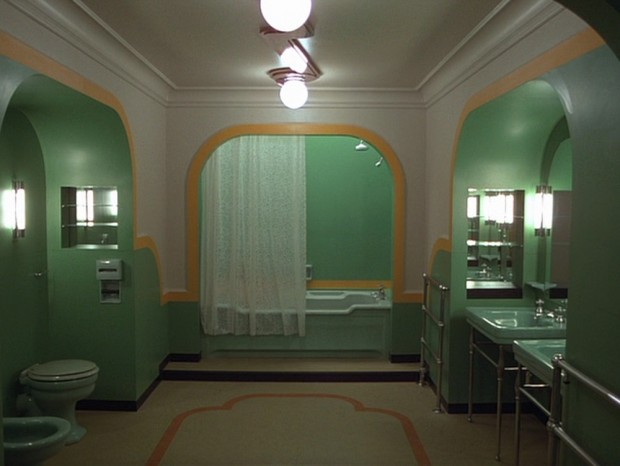
Fig. 17 - The green bathroom of Room 237.
Before I start making comparisons with the Boulder bathroom, I wanted to first return to Wendy and Danny exploring the heart of the maze and the brief glimpse we get of the arch close to the camera at the end.
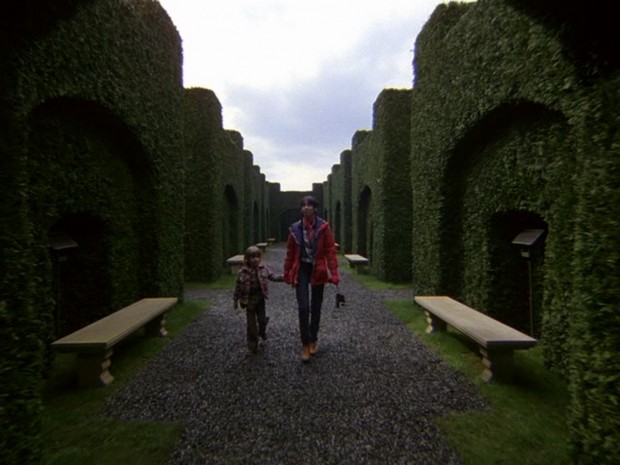
Fig. 18 - Wendy and Danny at the heart of the Overlook maze, a frame of arch showing in the right corner which means they've walked again to the end of it.
The brief shot of archway at the end of the heart of the maze anticipates this scene with its brief glimpse of arch in the upper right corner. A parallel is drawn. It woud seem we are at the heart of the Overlook's maze in this bathroom, as well as when in the hedge maze proper.
The Boulder bathroom had been tiled pink with green tones seemingly cast on it through and above the shower curtain by a green valance above an unobserved window beyond. In Room 237, we have the same green of the valance in the Boulder bathroom. The tub in the Boulder bathroom looks like it has been artificially altered so that its rim will recall the shape of the tub in Room 237.

Fig. 19 - The Boulder apartment bathroom in comparison with the bathroom of Room 237.
Room 237's bathroom is large with two sinks on one side (doubling) and a toilet and a bidet opposite the sinks in a glancingly symmetrical arrangement. The door is set into the same style of arched frame as observed above the sinks, the toilets and the bath. The mirror of the vanity in the Torrance's bedroom in Suite 3 is the same cloud shape as seen in the bathroom.
For the purposes of The Shining, this is its rainbow room.
We see the arch in the upper right hand corner once the door has opened, and have perhaps observed the arch with the camera's approaching the bathroom door, for it can be seen beyond if one is paying attention. This framing of the door with the arch, which we are briefly allowed to observe here in the upper right corner as a black silhouette, reminds me not only of the arch in the maze but of the black frame of the television set in Dick's home which we observed as the camera zoomed out of its picture. The silhouette of the frame of the door in the upper right corner in the bathroom reminds me of Dick's suggestion that what is being seen are like pictures in a book, just as what was being depicted on the television screen in Dick's bedroom wasn't actually happening in his room.
Doors are doubled throughout so that one can think of these doubled doors as affording two entrances onto a stage, two realities, two interpretations. Perhaps one is real, perhaps one is not. Perhaps both are real. Perhaps neither are real.
307 MCU Jack. (1:13:46)
We see Jack standing at the door, terrified. 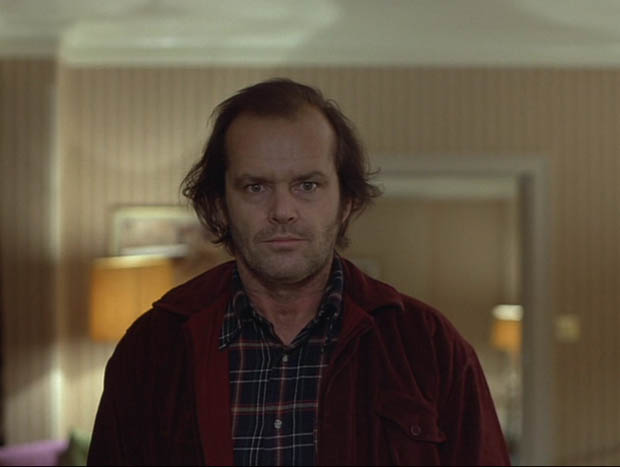
When shown the bathroom in their Overlook suite, Jack had blindly overlooked the shower curtain that had independently moved of any source.
Even in the Boulder bathroom, there had been an undefined shade behind the shower curtain, just below the light of the unseen window, resting at Danny's back.
It's time for us to see what's behind the curtain.
308 MS bathroom. (1:12:51)
Cut back to the bathroom. If we were uncertain before, we now have no doubt someone is in the bathtub. We see the shower curtain pulling back, a veil withdrawn to reveal a beautiful, young, nude woman.
There is one definite light source in the unusual zigzag design element in the ceiling, and another one or two that are indefinite, perhaps even unnatural.
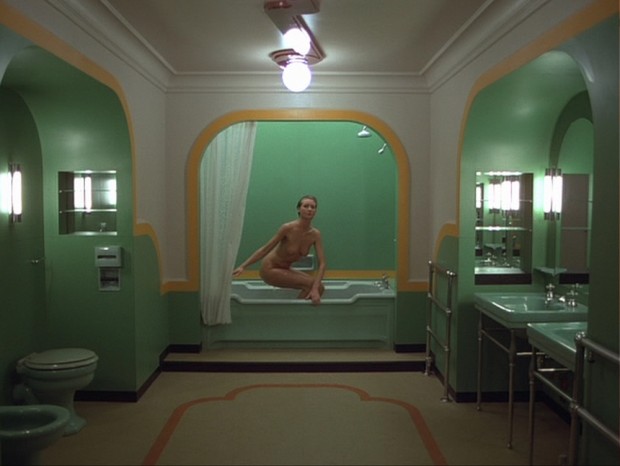
Fig. 20 - The woman rises from the bath in Room 237.
Below is a superimposition I did of Danny in the Boulder bathroom on the Overlook bathroom scene. I chose this still to overlay because it is one I had initially grabbed to show how closely the woman's posture aligns with the woman in the painting above Dick's bed in Miami. The two frames don't align perfectly. What I instead did was aligned one bathtub over the other and they are a true fit. You can see that Danny, standing on his stool, fits neatly in as if standing on the raised platform beside the green bathtub in Room 237. I've often wondered about that detail of the little yellow duck in the Boulder bathroom and we can see that, when combined with the Room 237 shot, the actress' hand blends into the duck's head, touching it. Also notice that the odd light in the ceiling fixture in the Room 237 bathroom, the lower portion of it aligns with the light in the bathroom at the Boulder apartment.
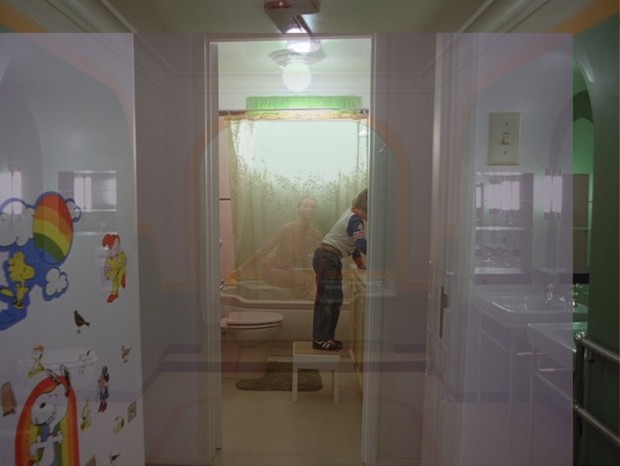
Fig. 21 - Not from the film. My superimposition of the two bathrooms to show how the bathtubs fit together perfectly, the woman seeming to rise out of the tub in Boulder.
For the fun of it, below is another superimposition showing how Dick's eye view (rather than our view of him) fits in with what is happening in Room 237.
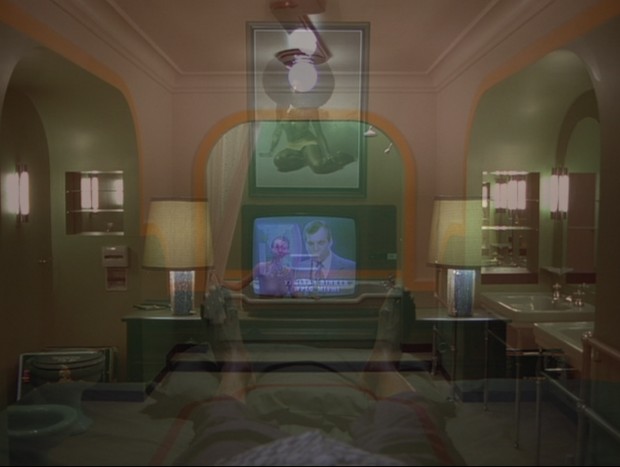
Fig. 22 - Not from the film. My superimposition of the Room 237 bathroom with Dick's television (as he began to have the vision while watching it), showing how the pillow on which his feet rests fits perfectly onto the space of the platform at the base of the tub.
You might have noticed that there's something else also up in that upper right corner. We had the arch. We also have sheen as if from a different type of paint, as if a high gloss used on a matte or semi-gloss.
The actress who plays the young woman is Lia Beldam. I can find no instance of Lia Beldam having worked in another film, and I wonder if she was perhaps chosen for her name, as beldam means an old woman, grandmother, (bel and dame) and is sometimes also given as being an ugly crone or witch. A little permutation gives bedlam, meaning "an insane person", and complements Wendy's having told Jack that Danny told her there was a crazy person in the room. The woman who plays the older version of her is credited as "Billie Gibson" and also appears to have appeared in no other film. I've wondered if Kubrick intended a link with Bill Gibson who directed "Footprints on the Moon: Apollo 11" in 1969, as Danny was wearing the Apollo rocket sweater during his professed confrontation with the woman in Room 237.
309 MCU Jack. (1:13:06)
Cut back to Jack. After a second his expression alters, breaking into an amazed leer.
310 MS bathroom. (1:13:15)
The woman in the bathtub rises, and as she rises her form briefly assumes nearly the same shape as the woman in the picture above Dick's head in Miami.
311 MCU Jack. (1:13:26)
Cut back to Jack's leer.
Somewhat amusingly, in Miami we can perhaps see a little word play of Mi ami, carrying in it the suggestion of a lover.
312 MS bathroom. (1:13:31)
The woman steps slowly, theatrically, dreamily, out of the tub.
313 MCU Jack. (1:13:40)
Again, a shot of Jack watching, smiling.
314 MS bathroom. (1:13:48)
The woman moves to the center of the bathroom where she stops, advancing no further, her eyes always upon Jack.
315 MCU Jack. (1:13:59)
Overcome with desire, Jack steps toward the camera, into the bathroom.
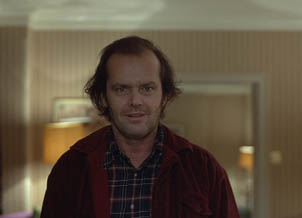 309 |
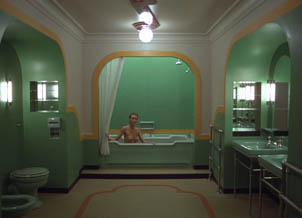 310 |
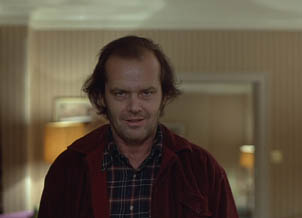 311 |
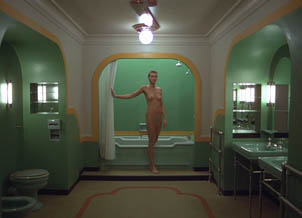 312 |
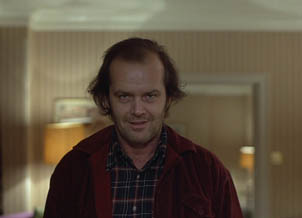 313 |
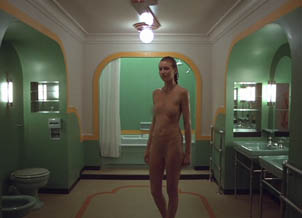 314 |
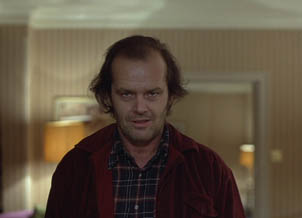 315 |
 316 |
316 MS bathroom. (1:14:05)
A shot from behind Jack now as he enters and approaches the woman. He stands facing her, the mirrors behind her. She touches him first, her hands moving up his chest, to his neck, appearing to linger briefly there, then wrapping her arms around his neck rather than strangling him as Danny was strangled. They share a passionate kiss.
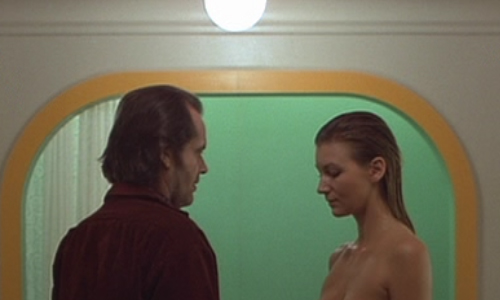
Fig. 23 - Jack with the woman

Fig. 24 - In what appears to be a production still, Lia's hair is darker and her head is held in a posture not seen in the film. Compare these two above shots of the woman with the woman in the white feather headdress and gold dress in the Gold Room.
317 CU Jack. (1:15:02)
Cut to a close-up, from behind the woman, of Jack kissing her. We see her hair is the same color as when they entered the embrace but the texture and color of her skin have changed. Several moments pass, they continuing to kiss, when finally Jack blearily half-opens his eyes. He doesn't react immediately. His eyes widen, however, when they focus on the mirror behind the woman and he draws back looking at the mirror rather than at her, as if at first he is only able to see her transformation in the mirror.
The camera pans rapidly to the mirror. In it we view Jack's astonished expression, and the putrefying but animated body of an elderly corpse he is embracing. Jack finally looks her in the face, releasing her. We hear her begin to laugh.
318 CU Danny. (1:15:25)
Cut to Danny, shaking, as we still hear the laughter.
319 MCU woman in Room 237 bathtub. (1:15:27)
Cut to a reanimated corpse in the bathtub belonging to, perhaps, an even older woman who has shorter hair. She's partially submerged. The wild laughter continues.
320 MCU Jack. (1:15:30)
Cut to Jack backing out the bathroom door, horrified by his embrace of the young woman becoming an embrace with death. He gasps.
321 MCU reanimated corpse. (1:15:32)
Cut to the reanimated corpse in the bathroom, following him, laughing, arms extended.
322 CU Danny. (1:15:35)
Cut to Danny, the laughter continuing.
323 MCU reanimated corpse in tub. (1:15:37)
Cut to the corpse in the tub again, beginning to now rise out of the water.
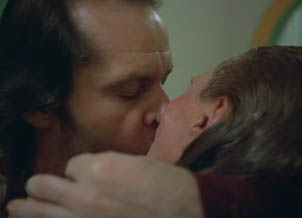 317 |
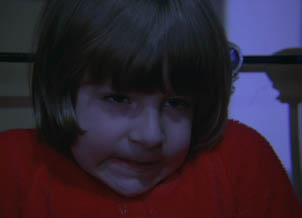 318 |
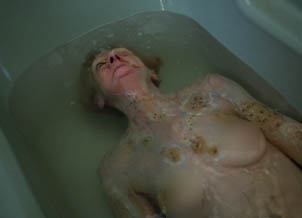 319 |
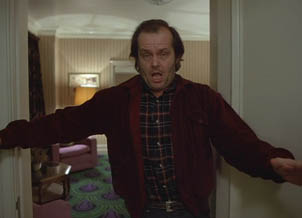 320 |
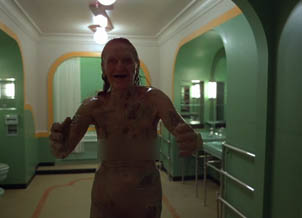 321 |
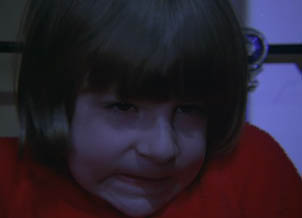 322 |
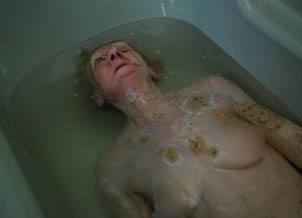 323 |
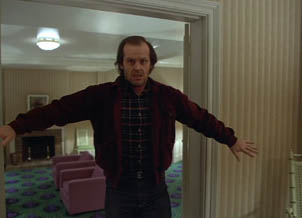 324 |
324 MS Jack. (1:15:42)
Cut to Jack backing out the bedroom door, he nearly falling down the stairs.
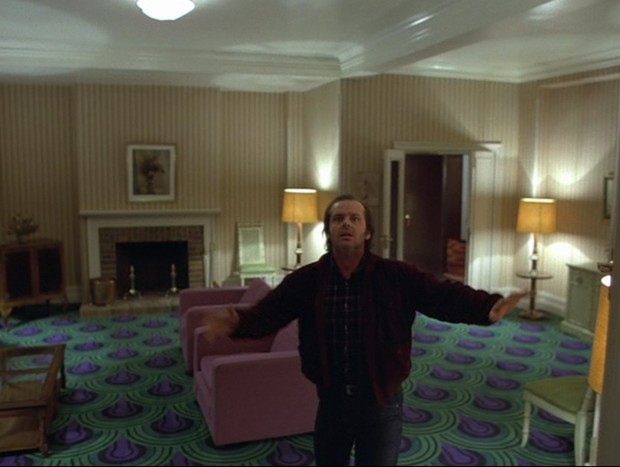
Fig. 25 - Jack backs down the stairs, horrified. We see the hall lit beyond.
How Kubrick manages the cascade of light from the lamps on the walls is of interest. With Jack's entry into Room 237, we have the screen right lamp positioned against a re-entrant angle (I guess you'd call it) which plays with the lamp light in such a way that it takes on the appearance of 2 birds, an upper one descending and a lower one ascending. We will see the same later in Suite 3.
Note that the hall lights exterior Room 237 are on.
325 MS Reanimated corpse in bedroom. (1:15:46)
The woman follows, now in the bedroom. She reaches the stairs.
326 CU Danny. (1:15:49)
Cut to Danny again in extreme close up.
327 MS Reanimated corpse in tub. (1:15:52)
Cut again to the corpse in the tub rising and as we get a better look at her face we see her putrefaction is in a more advanced state.
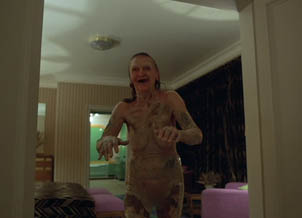 325 |
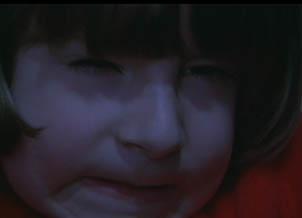 326 |
 327 |
|
328 MS hall outside Room 237. (1:15:55)
Jack backs out of the room into the hall outside Room 237. Though from inside Room 237, the hall was observed to be lit only seeming seconds before, the hall is now dark but for a ceiling lamp that shines before the double door at the end of it.
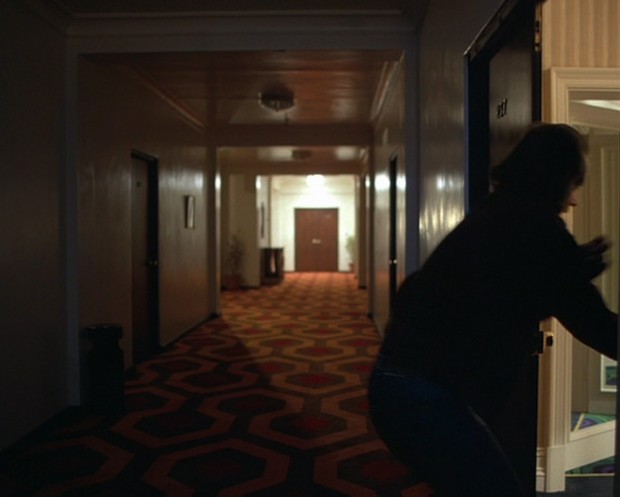
Fig. 26 - Jack exits Room 237 in a panic.
Kubrick isn't going to permit us to see what is in Room 237 from the hall. He didn't with Danny, he doesn't with Jack. All we're going to get are mirrors upon mirrors and a wee bit of corner angle of the carpet.
Jack slams the door and locks it as the woman's mocking laughter continues.
The camera ensures the audience sees the key violently swinging back and forth in the lock.
Three people shining--Dick, Danny and Jack--and who is seeing exactly what. We're not sure. A question is why the putrefying woman who rises out of the tub is so different yet the same as the woman who pursues Jack through Room 237? Considering how the scene is cut, it's reasonable that the putrefying woman rising from the tub is what Danny was shining, or perhaps Dick. But we don't know. We have no clue what version of the room it was that Dick or Danny were seeing.
JACK IN DICK'S MIAMI HOME
OTHER LINKS BETWEEN THE MIAMI HOME IN THE LODGE
329 MS Dick at home. (1:16:09 begin crossfade, ending at 1:16:13.)
Kubrick now overlaying the hall outside Room 237 with Dick's sun room in his home in Miami, we've a crossfade of Jack exiting the hallway into Dick's Miami apartment. See in the below images how Jack's arm is left extending into the hall as he exits and how it overlaps perfectly a plant in a rear room in Dick's apartment. Once we notice it, that plant becomes Jack's arm. It is as if Jack is still present in Dick's apartment. And the bright light behind Jack, in the hotel's hall, is replaced by the lamp in the rear room of Dick's place.
Note also that the doors to Room 237, with the crossfade, overlay Dick's bar and thus the "spirits" kept within, creating a link with the bar in the Gold Room and Jack's shining there. We see to the left, above Dick's bar, the mounted head of a mountain goat, a ram, another link to the mountain lodge and as well to the mounted animal heads in the Colorado Lounge which are to either side of the great fire place beneath the rainbow painting. In the goat we may also have Pan, the son of Dionysus, lord of alcohol. In the goat's head may be suggested the sacrificial ram that took the place of Isaac.
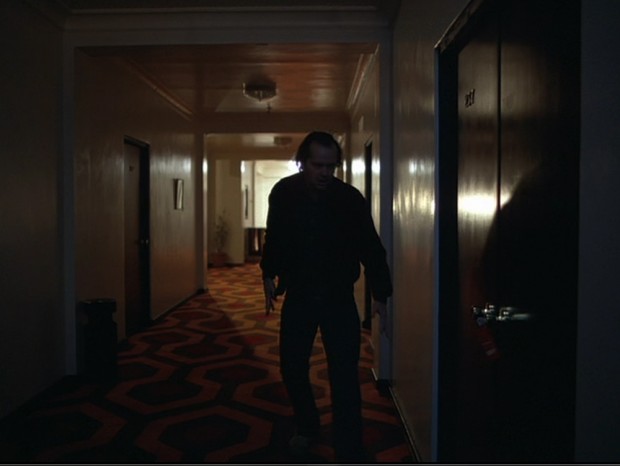
Fig. 27 - Jack backs down the hall toward the elevators in the balcony above the Colorado Lounge.
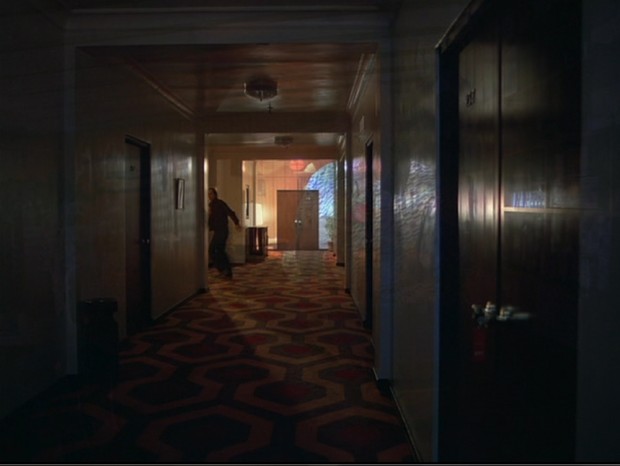
Fig. 28 - Kubrick crossfades from the hall outside Room 237 to Dick's home, imposing his bar over Room 237.
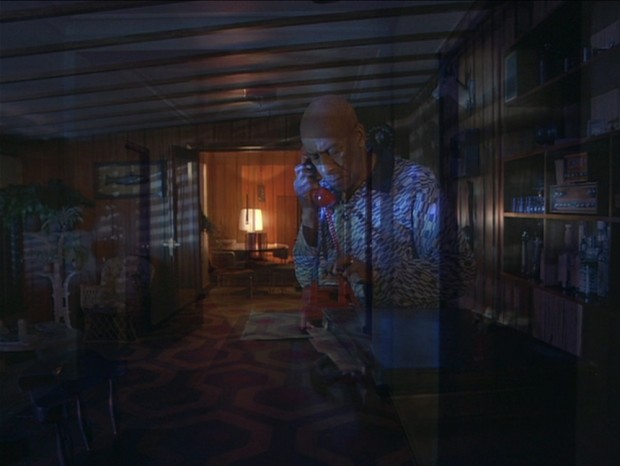
Fig. 29 - Via the crossfade, we have Jack's arm morphing into a plant in the rear room of Dick's apartment.

Fig. 30 - The completed crossfade.
Dick's "sun room", which we only view in the dark, has design elements that happen to overlap with the Summer of 42 movie seen on the television on Monday. We've the same slanted ceiling and exposed rafters in each.
Dick, in the dark sun room of his nice Miami home, in his pajamas, makes a phone call to the hotel, but it can't be completed as dialed for in the Saturday section we had the phone lines as down, for which reason Wendy had called the forest rangers on the lodge's two-way radio.
THERE IS NOTHING IN ROOM 237
JACK HAS SEEN NOTHING - DANNY FORESEES THE REDRUM WHICH HE WILL HIMSELF LATER WRITE - A PERMUTATION OF NOTHING, AIN, INTO A CONFRONTATION WITH SELF, ANI
330 MS Wendy in Suite 3. (1:16:49)
Cut to Wendy in their suite's bedroom. The bedroom lamp is in approximately the same position on the screen as the lamp in Dick's Miami household (see above), and so too does the image of the lake and mountain to the left of the lamp in the suite's bedroom, above the bed, correspond on the screen with the fish on Dick's wall.

Fig. 31 - The bedroom of Suite 3 where Wendy waits for Jack
If we overlay Dick's home atop the apartment, we see the lamp in the apartment's bedroom and the lamp at Dick's are exactly the same size. The way Wendy holds her hand up to her face somewhat mimics the pose of Dick talking on the phone.

Fig. 31a - The lamps are the same size
There's a knock on the hall door. She runs toward the camera, into the living room.
WENDY: Jack?
JACK (off-screen): Yes, it's me.
WENDY: Oh, thank god.
The camera follows Wendy down to the door which she unlocks, letting Jack in. There is now a key in the door with a plaque attached, like the red key to Room 237, but this key's card is a dark green.
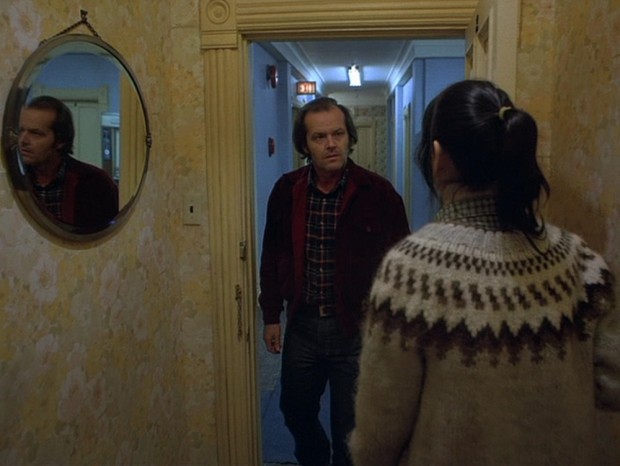
Fig. 32 - Wendy unlocks the door and lets Jack in.
The mirror shows the coffee machine outside in the hall. It isn't the same coffee machine as was in the hall when Wendy passed it in the "A Month Later" section bringing up breakfast on the cart. The coloring at the top is different, white instead of brown.
WENDY: Did you find anything?
JACK: No, nothing at all. (He shuts the door.) I didn't see one god damn thing.
Jack leads Wendy up the stairs.
WENDY: You went into the room Danny said? To 237?
JACK: Yes, I did.
WENDY: And you didn't see anything at all?
JACK: Absolutely nothing. How is he?
They've paused before Danny's partially open door.
WENDY: He's still asleep.
JACK: Good.
Jack closes Danny's door. As he turns to face Wendy, we briefly see again the key in the lock of the Suite's door down below. The key is now gently swinging. It wasn't in a brief previous shot.
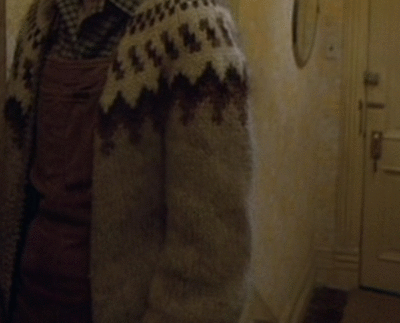
Fig. 33 - The key swinging in the lock. If the gif doesn't load, refresh the page.
This follows soon after Kubrick having shown us the key wildly swinging in Room 237's door with Jack locking it.
We also have the peculiarity of a lamp having been added to this foyer.

Fig. 33b - The additional lamp.
When we saw the foyer on Closing Day the lamp wasn't present just inside the door.
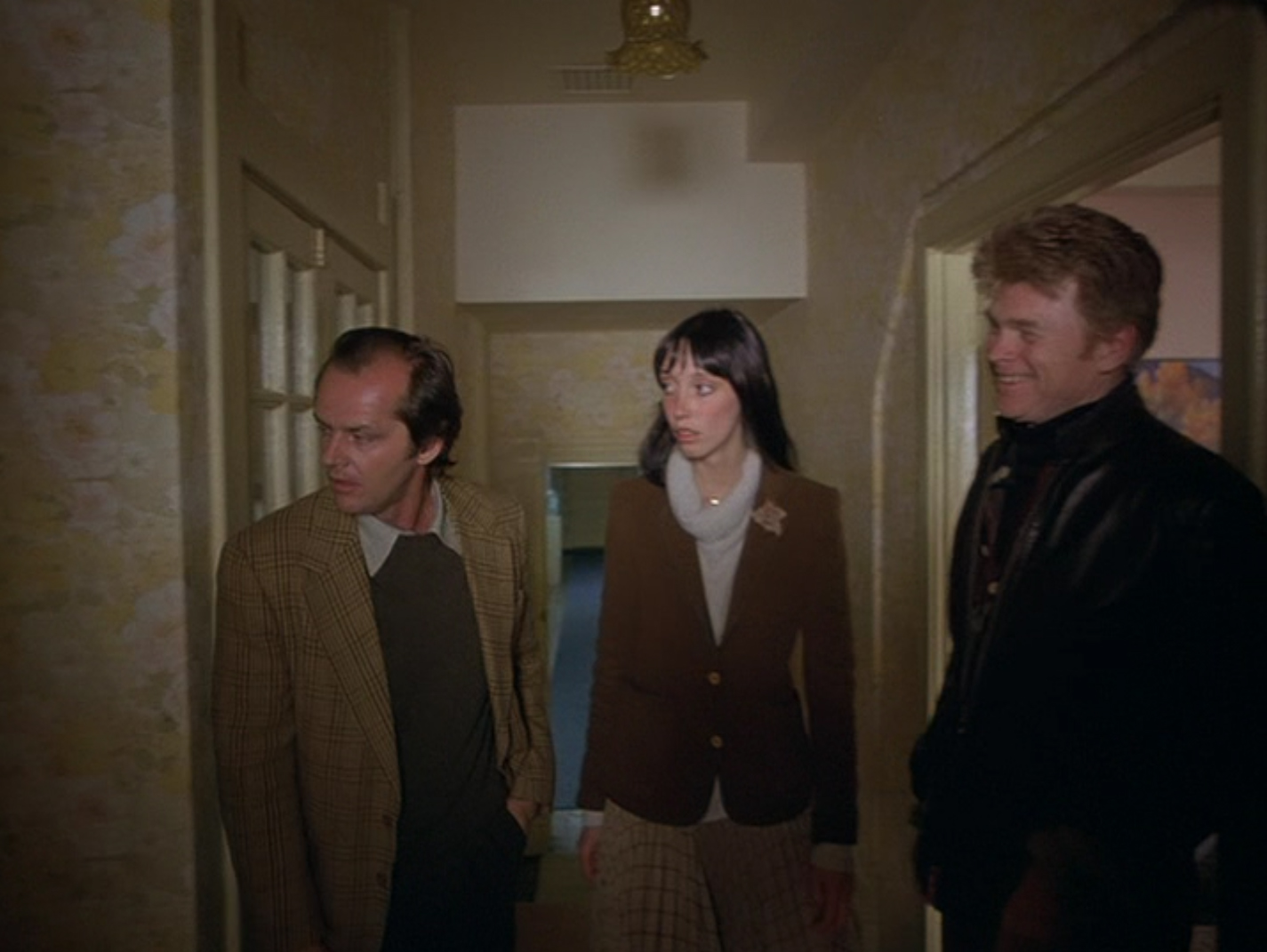
Fig. 33c - No lamp on closing day.
On Closing Day, Kubrick took special care to show this portion in which we see what appears to be a forced air duct, and the bottom of an amber lamp. The way the shot is framed, the camera situated further back, we don't even notice the new lamp in this section with the camera now being more forward, placed directly within the door. We rather feel as if we're seeing the same shot and the same lamp, when we are not.
JACK (directing Wendy into the living room): I'm sure he'll be himself again in the morning.
The camera following them into the living room, Wendy questions Jack.
WENDY: Well, are you sure it was the right room? I mean, maybe Danny made a mistake.
JACK: He must have gone in that room. The door was open and the lights were on.
We wonder why Jack says he saw nothing, considering our observation of the horror he'd just witnessed. Has he forgotten what he has seen, just as Danny, upon waking up, sometimes forgets what Tony has told him? Does he feel guilt over his embracing the apparition of the young woman and that he must hide what he's seen? Is he shielding himself from the devastating vision? Is he aware, but lying, as he can't admit what is there in the lodge as he has become so connected with it that he won't leave under any circumstances? It does seem that he no longer remembers, but was certainly in the room. Just as down in the bar he was jolted awake when Wendy entered and seemed to show no memory of his talk with Lloyd, we have a Jack who seems to be two people, much like the girl who appears to Danny as seeming twins.
To be considered is the fact Dick told Danny there was "nothing" in Room 237, and that with the CH O KING poster we have the prominence of the big fat O.
Also, again, do we really know what Jack saw? We know that Jack went to Room 237, but we saw both Dick shining and Danny shining the room. We have three simultaneous visions overlaid and are working on the assumption that what we observed was what Jack had seen.
331 CU Wendy. (1:18:05)
Wendy has seated herself on the bed.
WENDY: What about those bruises on his neck?
332 MCU Jack from behind Wendy. (1:18:13)
WENDY: Somebody did that to him.
JACK: I think he did it to himself.
333 CU Wendy. (1:18:31)
WENDY: No, that's not possible.
334 MCU Jack from behind Wendy. (1:18:40)
JACK: Wendy, once you rule out his version of what happened, there is no other explanation, is there? It wouldn't be that different from the episode that he had before we came up here. Would it?
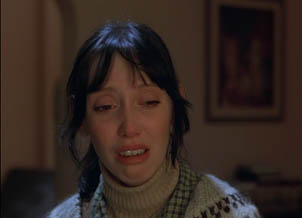 331 |
 332 |
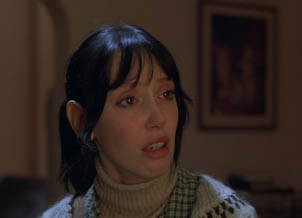 333 |
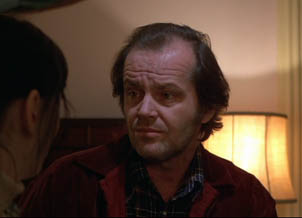 334 |
335 MCU Danny in bed. (1:19:05)
Cut to Danny on his bed, facing away from the door, eyes wide with horror.
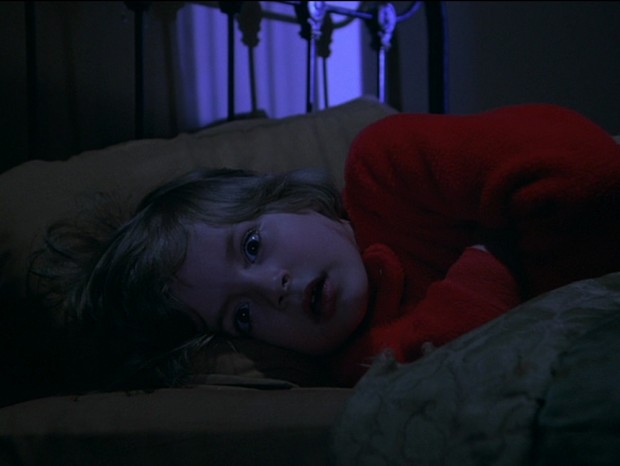
Fig. 34 - Danny listens in horror.
The heartbeat has begun again. We hear, submerged in a deep, watery echo, Wendy saying, "Whatever the explanation is..."
336 MCU the REDRUM door. (1:19:15)
A low shot, looking up on the bathroom door on which is the lettering REDRUM in red.
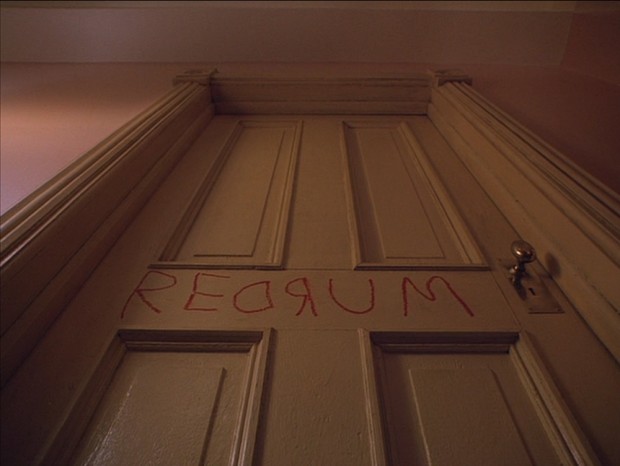
Fig. 35 - The first apparition of REDRUM.
I don't think there's any ignoring the possible associations that come with the REDRUM appearing in a cross. But here, with the foreshortening, it is almost a form of inverted cross which brings in "The Hanged Man". Rather than being concerned with martyrdom, the card can have to do with the mystery of death and resurrection. In the Waite tarot, the hanged man's leggings are red and his tunic is blue, which duplicates Jack's appearance in the bedroom when Danny went to his room for his fire engine. Plus, Jack is observed in the mirror, and when Wendy first sees redrum and interprets it as "murder" it is in the same mirror. This upside down suspension of the Hanged Man may link with the reversal of redrum in the mirror.
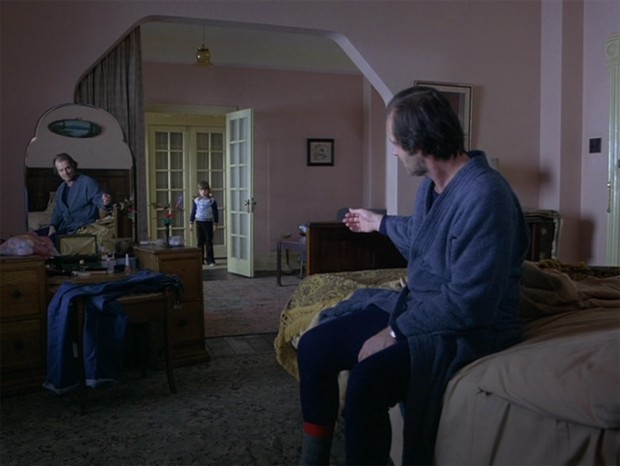
Fig. 36 - Jack, on Monday, seen in the same mirror as Wendy will later see REDRUM.
If we look back to Dick's sun room, notice that we have just seen a cross on his sunroom door formed by the doorknobs and the jamb.
337 MCU Danny. (1:19:16)
Cut to Danny still staring in horror.
WENDY: I think we have to get Danny out of here.
We don't witness Danny envisioning Jack's attack with the axe. Instead we see the word REDRUM, which Danny will himself write later, so his envisioning it is much like a creative fantasy upon which his later physical action is formed.
338 CU Jack from behind Wendy. (1:19:23)
Jack is horrified by her insistence that they leave.
JACK: Get him out of here?
WENDY: Yes.
We hear sounds very similar to those in the "Dies Irae" opening section of the film.
JACK: You mean just leave the hotel?
339 CU Danny. (1:19:42)
Cut to Danny's mouth wide open in a silent scream.
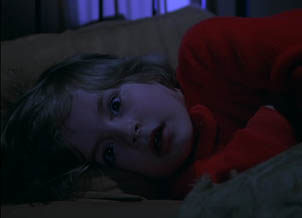 337 |
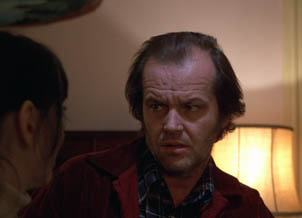 338 |
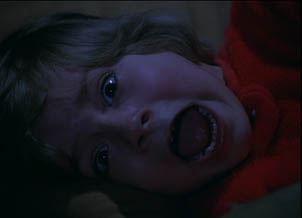 339 |
|
340 MS the bloody elevator hall. (1:19:43)
A vision of the bloody elevator hall. Blood gushes from the elevator, filling the hall.
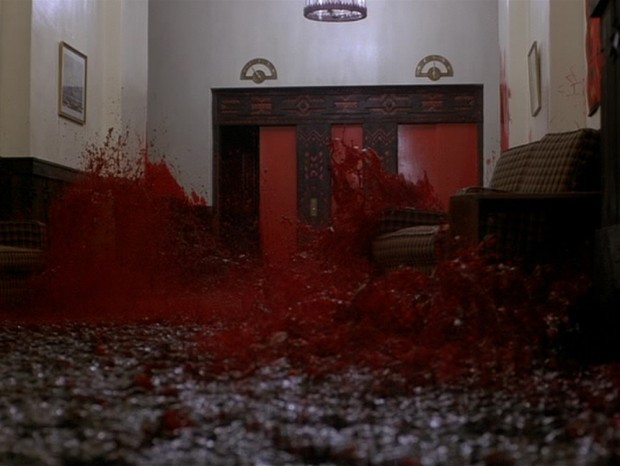
Fig. 37 - Danny sees the bloody hall.
As with the vision Danny had in Boulder, the blood splashes up on the screen, blacking it out.
JACK: It is sooo...
341 CU Jack from behind Wendy. (1:19:48)
JACK: ...fucking typical of you to create a problem like this when I finally have a chance to accomplish something! When I'm really into my work! I could really write my own ticket if I went back to Boulder now, couldn't I?
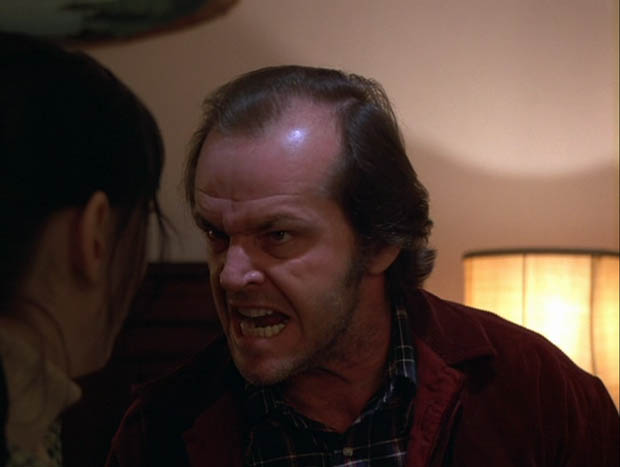
342 MS Wendy and Jack. (1:20:00)
Cut to Jack rising up from the bed.
JACK: Shoveling out driveways, working in a car wash, wouldn't that appeal to you?
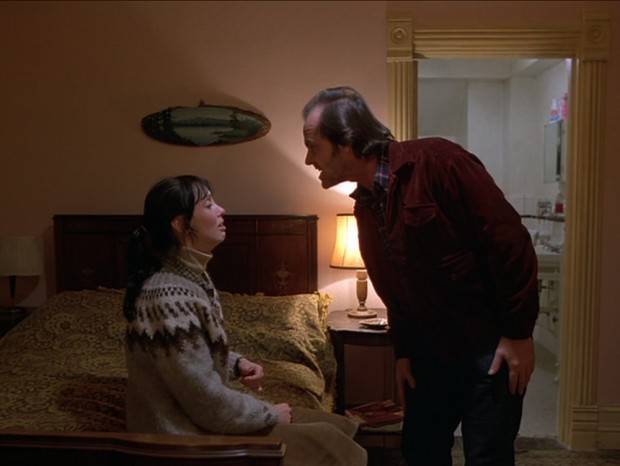
Fig. 38 - Jack turns on Wendy in a fury.
Notice now in the bathroom, following the first appearance of REDRUM, the bottle of red fluid on the shelf above the sink. It would be likely mouthwash but we've not seen it before.
WENDY: Jack...
JACK: Wendy, I have let you fuck up my life so far but I'm not going to let you fuck this up!
343 MS Jack. (1:20:15)
The camera POV backs off now to the hall door to the living area. Jack stalks out of the room, the heart beat continuing, casting an enraged snarl at the camera (Danny's room). The camera follows as he enters the hall and exits the front door of the suite, the door slamming against the wall.
344 MS Wendy. (1:20:23)
Cut to Wendy on the bed, crying.
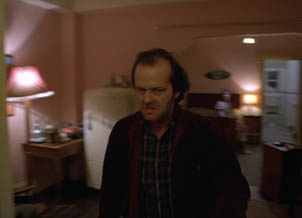 343 |
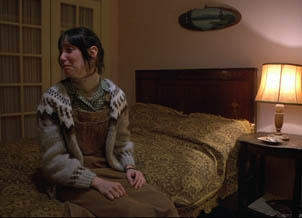 344 |
So, back to this idea of Jack telling Wendy he found nothing in Room 237. If you return earlier in this section to the quote I brought in from Wikipedia, concerning the 10 aspects of the divine, the 10 enumerations of the sephiroth of the tree of life, you'll see the word ain. AIN, ayin, in Hebrew comes from a root meaning to be nothing or not exist. An identical ayin is instead used in the sense of query, as in "where, whence". Switch around the letters (permutation) to be ANI and we instead have the word "I". This I is specifically used by the god in Genesis who brought the flood waters of the earth, and then set the covenant of the "bow", QShTH, in the cloud, as the token of a covenant, causing that god to remember, ZKR, his covenant that he would no longer destroy all flesh by a flood. Thought I'd just throw that in since we have the rainbow in the Colorado lounge and here we have Danny listening to Jack's voice as though through water. Or blood.
What is going on also is that by the 4 p.m. section we're going to be shifting into Passover ideas and musical commentaries concerning it which are already being brought up here, and I'd just kind of like to hold off until the 4 p.m. section to get into that.
The emotional content to this scene, Jack's abuse of Wendy, I write about in The Real Horror of The Shining -- The Misogyny of the Audience for Wendy Torrance. It's a powerful scene and Wendy's flinching yet still uncertain terror is perfectly played, as is Jack's explosive rage.
THE MASQUERADE
345 MS Jack. (1:20:32)
Downstairs in the service hall that is around the corner from the office, the one they had walked down on Closing Day on their way to the boiler, Jack stalks about sweeping objects off shelves--coffee decanters and other items. On closing day, cases of 7-Up had been stacked to the right side as they entered from the service hall behind the office. Now we have an oppositional view and the 7-Up has been moved so that is instead forward in the hall rather than to the rear.
To the rear we see double staff doors. I've never been able to figure out what is going on with the glass of the left door. Duct tape? What?
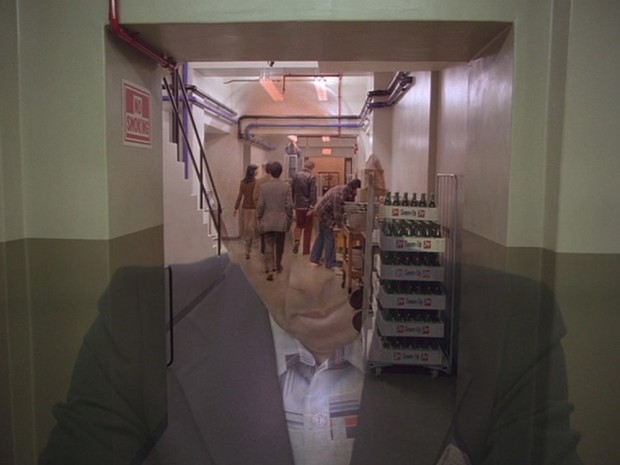
Closing Day - Crossfade from the 7-up hall to Dick with Danny in the kitchen.
That we have an oppositional view from Closing Day, and that the 7-Up trays have been moved to keep them forward is a good example of how Kubrick works with a space and the audience's relationship to it.
As Jack enters the hallway that leads up to an intersection with the elevator hall off the lobby, we see behind him potted plants that are dead. He begins to hear music.
Jack is well able to see before we do something is off, his eyes focusing already on something unexpected on the floor, though this hall appears normal to us.
As he comes to the short hall that passes the lobby elevators, he stops before the diamond wall hanging.
We get to see vaguely the paintings to either side of the wall hanging.
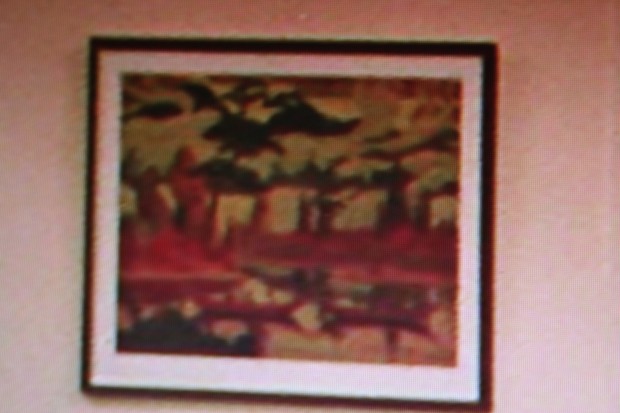
Fig. 39a - Painting beside the earth-toned diamond rug.
What is that? The River Styx being traversed by canoes?

Fig. 39b - Mist Fantasy by James Edward Hervey MacDonald
A reader named Neal kindly wrote and informed me the painting was James Edward Hervey MacDonald's "Mist Fantasy". MacDonald, born in England, was a Canadian painter who, beginning in 1924, would travel in the summer to the Rockies to paint. But this painting is from 1922. In 1973 it was used for a Canadian postage stamp commemorating MacDonald.
In Barry Lyndon, during the most traumatic period, when the loss of a child occurs, Kubrick shrouds the landscape in a mist that ascends after the child's death.
346 LS lobby. (1:21:11)
There are balloons and ribbons everywhere. We notice that the potted plants beside the elevators are withered, as if this is a perspective of the hotel in which care has not been maintained over the winter months, the plants allowed to die. Jack Hylton's "The Masquerade" (music supplied by another Jack, more doubling) can be heard playing from the ballroom. The camera begins a slow zoom on the Gold Room hall door and we hear Jack's footsteps.
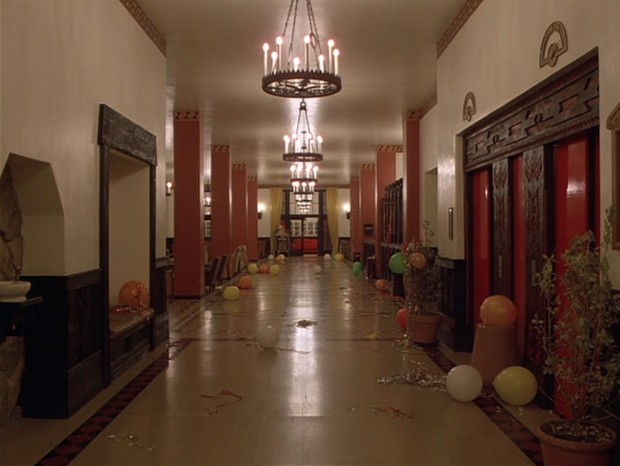
Fig. 40 - Jack hears "The Masquerade".
While life soon will fade,
I'll meet you at the masquerade,
While our hearts swinging to violins singing ‘til dawn.
Lady dressed in jade,
Hold me tight at the masquerade.
If the music halts here then my heart will waltz here, right on.
Twelve o'clock is chiming on the clock up above.
Now if you unmask your heart, I'll love you, love you…
Midnight, shadows fade;
No one's left at the masquerade.
Everything is through dear, but my love for you dear, lives on.
DICK CALLS THE FOREST RANGERS
347 MS Dick. (1:21:23)
Cut to Dick in his dark Miami sun room making another call, this time to the forest rangers.
NIGHT FOREST RANGER: Good evening, fire service.
DICK: Hello, my name is Dick Hallorann. I'm the head chef up at the Overlook Hotel.
NIGHT FOREST RANGER: Good evening, Mr. Hallorann, what can I do for ya?
DICK: Sir, I've been trying to make an urgent phone call up there but the operator said that the phone lines are down.
348 MS fire service. (1:21:49)
NIGHT FOREST RANGER: Yeah, I'm afraid a lot of lines around here are down due to the storm.
349 MS Dick. (1:21:52)
DICK: Well, look, sir, I hate to put you through any trouble but there's a family up there all by themselves with a young kid. And with this storm and everything, I'd sure appreciate it if you could give them a call on your radio just to see if everything's okay.
 347 |
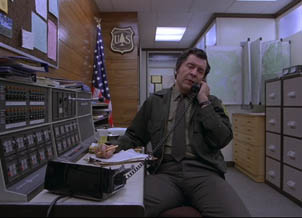 348 |
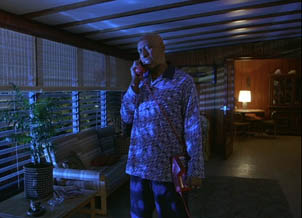 349 |
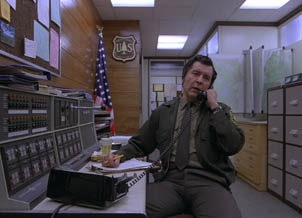 350 |
350 MS fire service. (1:22:05)
NIGHT FOREST RANGER: I'd be glad to do that, sir. Why don't you call me back in about 20 minutes.

Fig. 41 - The night forest ranger.
DICK (off-screen): Thank you, very much. I'll do that.
NIGHT FOREST RANGER: All right, sir.
He hangs up.
A fun note, this style of coffee cup the ranger is using can be observed being used on the set in Vivian's documentary on the film. Kubrick is drinking from it when he is working on script at the kitchen table. They are preparing to film Wendy dragging Jack to the storage room and Vivian is talking about line readings and then even mentions the two-way radio, so it seems this cup was destined to appear in conjunction with the two-way radio, though the ranger is using the phone. Later the ranger will relate he tried to reach The Overlook by two-way radio but was unable to do so.
GOOD EVENING, MR. TORRANCE
MIDNIGHT, THE STARS AND YOU - THE WOMEN WITH THE WHITE FEATHER HEADDRESS AND THE GOLD DRESS - THE HAND PRINT, THE ADVOCAAT AND CARSON CITY - THE OLD WOMAN FROM ROOM 237 IN THE GOLD ROOM
351 LS Jack in the Gold Room hall. (1:22:16)
Jack advances down the hall to the Gold Room, big band music playing. "Midnight, the Stars and You". The scene has a similar quality of haze as was in the scene of the office on his day of the interview. We might think of the "Mist Fantasy" painting just observed.
Midnight, with the stars and you;
Midnight, and a rendezvous.
Your eyes held a message tender,
Saying, "I surrender all my love to you."
Midnight brought us sweet romance,
I know all my whole life through
I'll be remembering you,
Whatever else I do,
Midnight with the stars and you.

Fig. 42 - Jack advances toward the Gold Room.
Now, the disappearing bread crumb. This is just kind of fun to point out. See the little white dot on the screen above just left of center? (I was about to write just right of left, because I'm dyslexic and things can get weird when it comes to directions.)
If you can't see the white dot above, here it is circled below.

Fig. 43 - A trail of bread crumbs in the maze?
Click on images to see larger. Here it is again.
As Jack advances it briefly and noticably brightens.

Fig. 45 - The crumb brightens (in the blu-ray as well).
It fades.
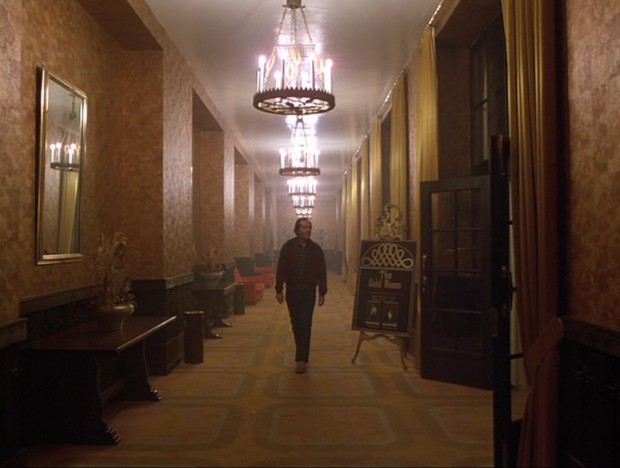
Fig. 46 - The crumb fades as Jack comes to the door.
It disappears as Jack turns to go into the Gold Room.
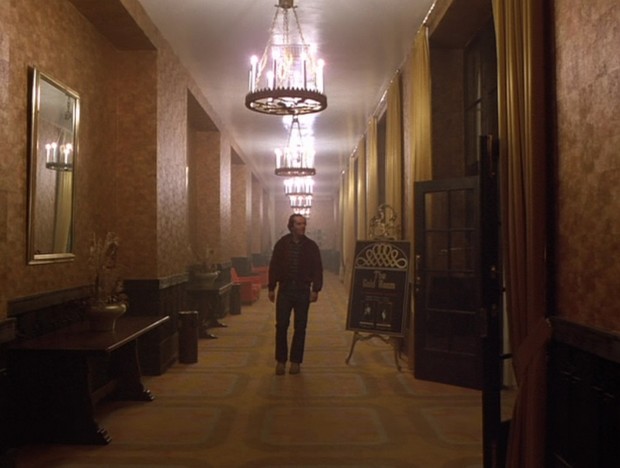
Fig. 47 - The "crumb" disappears.
The white flecks on the carpet and in the blood of the two girls have always caught my attention.
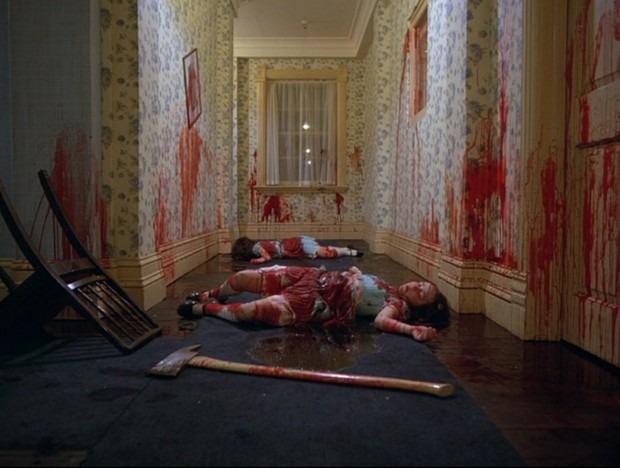
Fig. 48 - The white flecks sprinkled about the carpet and in the blood bath.
What happens if we merge the white dot in the gold hallway with the two girls? Two things. The white "bread crumb" from the gold hall is the size of the white flecks scattered about the girls (it is the fleck closest in the foreground). Another thing, Jack's shape merges pretty much perfectly with a bloody stain on the foremost girl's dress.
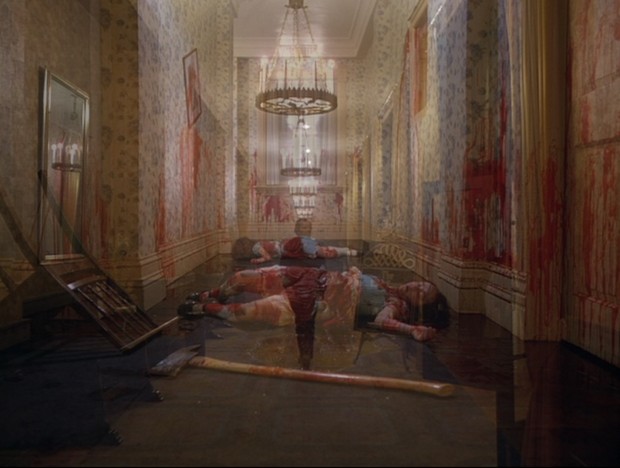
Fig. 49 - This is my superimposition, not in the movie. The peculiar "crumb"is of the same size as the white flecks sprinkled about the murder scene.
It occurred to me the axe seemed positioned so that Jack could rather follow it into the Gold Room. So, let's keep this superimposition going for another couple of images.
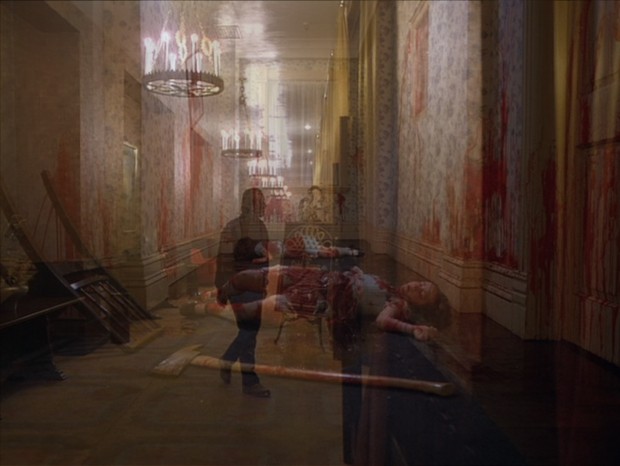
Fig. 50 - This is my superimposition, not in the movie, of Jack following the axe handle into the Gold Room.
He enters through the main door while the camera enters a door over, a moment of transitional black occurring just as on Closing Day when the Torrances had entered the Gold Room with Ullman and Watson. A 1920's party in full swing, Jack is greeted by the maitre'd at the door who addresses him by name.
MAITRE'D: Good evening, Mr. Torrance.
JACK: Good evening.
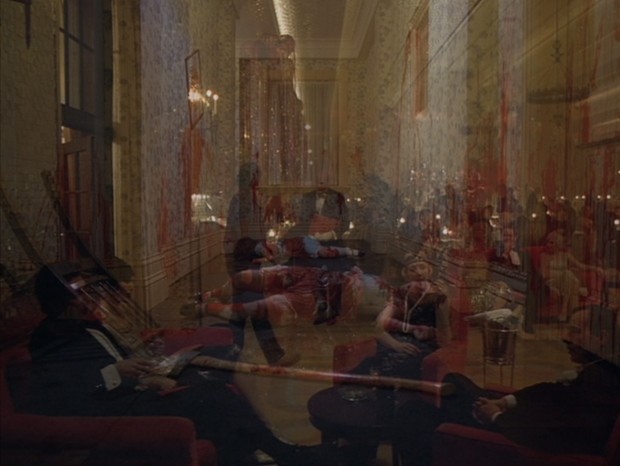
Fig. 51 - This is my superimposition, not in the movie. I only wanted to show how the girl's arm aligns with the woman's.
That's as far as I'll take this superimposition. I just wanted to show how Jack's form briefly fitting in with a blood stain on the girl is followed by the bent arm of the foremost girl coincidentally and nearly perfectly aligning with the woman whose arm is resting on her lap.
The reason the white dots interest me is because of their being mysteriously sprinkled about on the carpet and in the blood of the girls in the murder hall. They stand out so much in the scene of the dead girls that some wonder if the dots might be snow. And then this white dot in the Gold Room hall stands out as it brightens then fades and disappears. I call them bread crumbs because in the kitchen, when with Dick, Wendy had said the place was like an enormous maze and that she felt she would have to leave a trail of bread crumbs.
The ballroom is decorated with multicolored balloons, these forming a rainbow arch at the front of the room. One could say this had been anticipated by Danny's bedroom door upon which we saw the helium balloon above the rainbow. The helium balloon had been repeated in his room after his vision, appearing as a toy in the upper right corner.
Progressing to the bar, Jack passes 4 tables on his right. The first has two men, an older woman in a black dress with a black feather in a headband, and another woman. The second table has two men, a woman with a black feather in a headband and a gold and black dress, and another women. The third table has two men, a woman with dark hair and a white feather in a headband and a gold dress, and another woman in a black skull cap and black dress with a white pattern. Some of these people pass Jack later while he is talking with Lloyd, which is the reason I make note of them now.
Jack finds Lloyd at the bar and seats himself.
JACK: Hi, Lloyd. I've been away but now I'm back.
LLOYD: Good evening, Mr. Torrance, it's good to see you.
Lloyd places a bowl of olives and one of nuts before Jack.
352 MCU Jack. (1:23:10)
JACK: It's good to be back, Lloyd.
353 MCU Lloyd. (1:23:13)
What will it be, sir?
354 MCU Jack. (1:23:16)
JACK: Hair of the dog that bit me.
Jack says this as behind him passes to the right the woman from the third table who had been wearing the skull cap, along with the older woman from the first table who had the black feather in a headband. The older woman is now wearing a coat over her dress that we'd not observed with her at the table.
355 MCU Lloyd. (1:23:20)
LLOYD: Bourbon on the rocks.
356 MCU Jack. (1:23:22)
That'll do it.
As Lloyd pours, from the apparently real bowl of nuts Jack takes a real few and eats them, but he does it in such an exaggerated fashion he looks as if he is only miming the action in broad strokes to make it read for us.
357 MCU Lloyd. (1:23:28)
Cut to Lloyd pouring.
358 MCU Jack. (1:23:32)
Cut to Jack taking his wallet from his pocket.
In the earlier scene of Jack in the bar, Jack had said he'd two 20s and two 10s in his wallet, but when he opened his wallet they were gone. Now, he pulls cash out of his wallet ("...saying I surrender, all my love to you," the lyrics run at this moment). Though most people wouldn't think of it in this way, I look on this as another example of things disappearing and reappearing, though we've no assurance Jack ever had any cash on him.
Lloyd refuses the money.
LLOYD: No charge to you, Mr. Torrance.
Behind Jack passes, with a couple of other individuals, the woman from the second table wearing the black feather headdress and the gold and black dress.
JACK: No charge?
359 MCU Lloyd. (1:23:43)
LLOYD: Your money's no good here.
360 MCU Jack. (1:23:47)
Cutting back to Jack, we view passing again behind him, with a couple of other individuals, the woman from the second table wearing the black feather headdress and the gold and black dress.
361 MCU Lloyd. (1:23:51)
LLOYD: Orders from the house.
362 MCU Jack. (1:23:54)
JACK: Orders from the house?
Now pass behind Jack two men from the first table, a shorter man with a red carnation on the outside and the taller man on the inside.
363 MCU Lloyd. (1:24:02)
LLOYD: Drink up, Mr. Torrance.
 352 |
 353 |
 354 |
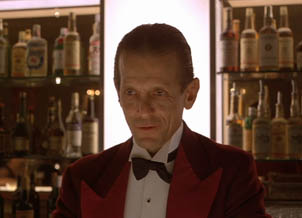 355 |
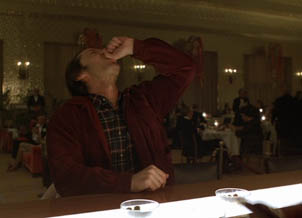 356 |
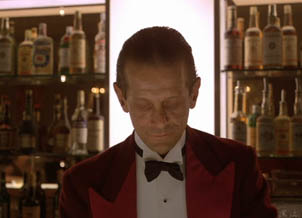 357 |
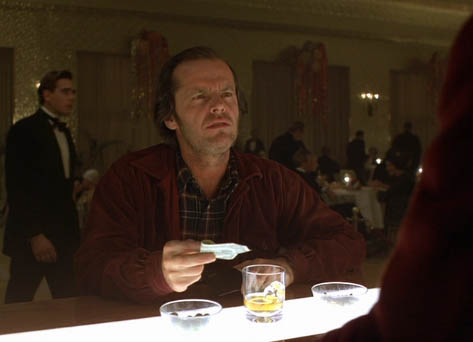 358 |
 359 |
 360 |
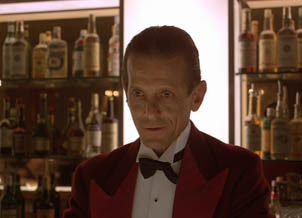 361 |
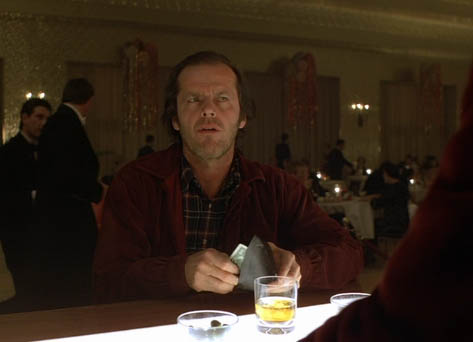 362 |
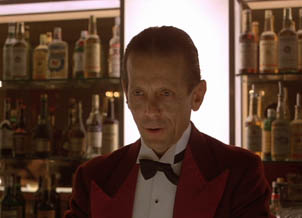 363 |
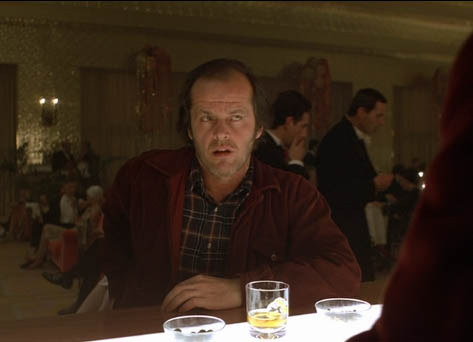 364 |
|
364 MCU Jack. (1:24:05)
As the camera cuts back to Jack we see the same two men passing behind him again, this time the shorter man on the inside of the pair, an intentional mirrored doubling of the men occurring.
JACK: I'm the kind of man likes to know who's buying their drinks, Lloyd.
As Jack says he wants to know who's buying his drinks, a woman with a white feather in her hair, wearing a gold dress, walks past to the left. The white feather is in the same style of wide headband the woman at the third table had been wearing, but it isn't the same woman. A bracelet is on her right wrist.
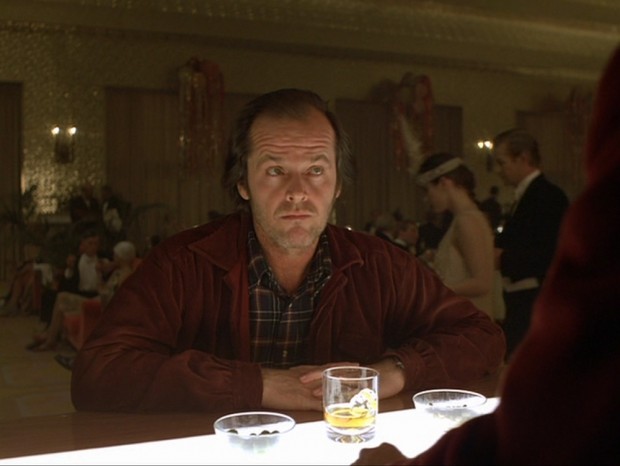
Fig. 52 - Woman with a feather headdress.
365 MCU Lloyd. (1:24:13)
LLOYD: It's not a matter that concerns you, Mr. Torrance. At least not at this point.
366 MCU Jack. (1:24:19) Jack deliberates a moment then smiles.
JACK: Anything you say, Lloyd, anything you say.
 364 |
 365 |
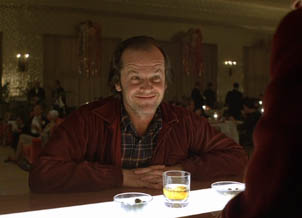 366 |
|
367 MS Jack. (1:24:29)
Jack dances a few feet away from the bar with his drink, his back now to the camera.
A woman with a single white feather headdress, wearing a gold dress, a bracelet on her right wrist and two bracelets on her left arm, now enters from the right--and she would be intended to "double" the woman with the white feather who had passed earlier when the subject of who was paying for the drinks came up, but the headband holding this woman's feather is slimmer and it passes under the back bun of her hair rather than above it. She looks as though she may even possibly be the young woman who was in the bath, having the same build, but we're intentionally not given an opportunity to see her face, her back to us as she quickly continues on.
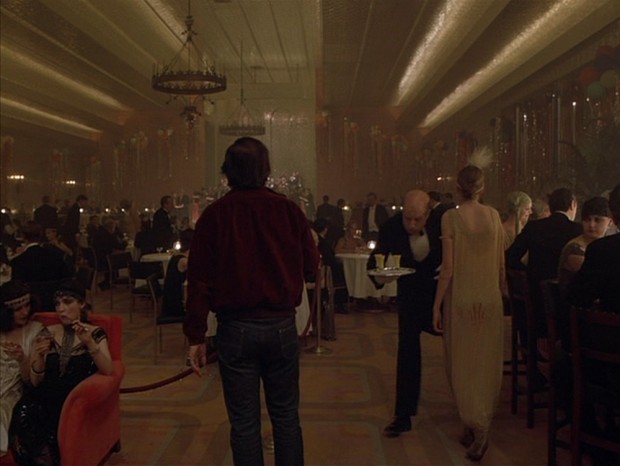
Fig. 53 - The woman in the dress with the red design on the rear.
We see on the bottom rear of her dress a seeming red crown/feather design that resembles as if someone had patted her bottom. An allusion to a bloody handprint? If we return to the crossfade from Room 237 to the boiler room, we see that a square of dark carpeted area of the room had obscured briefly the same area of Wendy's dress. I only pick this out as being potentially significant as this was when Danny entered the room where he would be choked (resulting in the red hand print on his throat) and later, with the scene of the individual in the "bear" costume, the bottom is cut out revealing his rear, much like a drop seat.
The placement of the design on the seat of her dress is, one must admit, most unusual.
This section is greatly concerned with handprints, as we'll see.
This woman's sole purpose here is to nearly collide with a waiter, either eerily purposeful in the coordination of the domino effect which occurs, or so oblivious that she seems not at all to realize the waiter is there, he thus knocking into Jack in his effort to avoid her.
Jack, colliding with the waiter, is in approximately the same position he was in when he met Dick and shook hands with him in the ballroom on Closing Day. Not the exact position, just approximate, as he now is beside the red sofa.
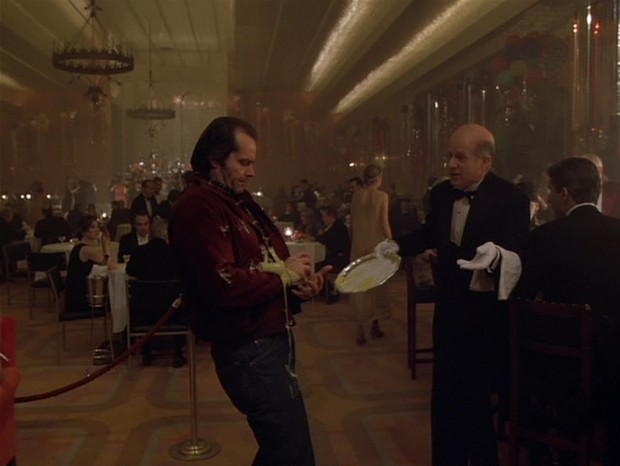
Fig. 54 - The waiter collides with Jack.
I would think that this collision is anticipated by Jack's knocking about of the "silver" in the 7-Up hall preceding this, sending it all over the floor, which was followed and echoed by Jack then seeing the balloons and streamers littered about the floor in the lobby. There are all around the hotel the signs urging that it be kept clean, and Jack's job is, after all, to maintain it. The ball Jack loses becomes the bait for Danny to approach Room 237 and enter it. That might be a case of not keeping the hotel clean and trouble following. Jack sweeps a number of objects onto the floor of the 7-Up hall, and immediately thereafter he sees the floor in the lobby littered with balloons.
GRADY (apologizing profusely): Oh dear, oh dear. So sorry, sir. I've made an awful mess of your jacket.
The liquid spilled on Jack is a bright yellow and we will see that the two spots it leaves on the white paper on the silver tray look distinctly like the eggs served to Jack, by Wendy, in the "A Month Later" section, when Jack revealed to her his profound sense of deja vu. To the rear in that scene, on the bed, had been a wood inlay design in the headboard of the bed, the feminine aspects of which were amplified with the crossfade to the next scene of Jack playing handball in the Colorado Lounge.
There's a reason the yellow advocaat so resembles the eggs Wendy had served. Advocaat is a liqueur made from a blend of egg yolks, sugar, brandy and vanilla.
JACK: Oh, that's all right, I've got plenty of jackets.
Perhaps we've a play here on Jack's name. As if there is more than one Jack.
GRADY: Afraid it's Advocaat, sir, it tends to stain.
JACK: Advocaat, is it?
GRADY: Yes, Advocaat. I think the best thing to do is to come along to the gentleman's room, sir, and we'll get some water to it, sir.
JACK: Looks as though you might have got a spot of it on yourself, there, Jeevesy, old boy.
Following the waiter to the bathroom, Jack twice pats the waiter's back, leaving a hand print on his left shoulder.
GRADY: That doesn't matter, sir. You're the important one.
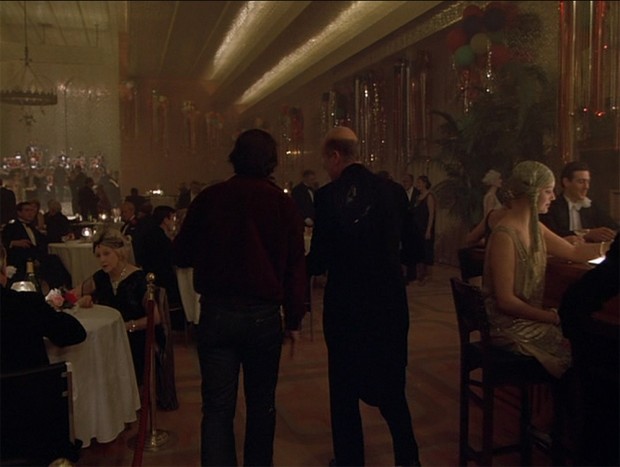
Fig. 55 - Rounding the corner of the bar with Grady.
A brief clip of the movie Carson City had been on Wendy's television when Jack called to say he'd gotten the job. In a scene not shown in The Shining, when silent Jeff returns to his home town of Carson City, having been gone for a long while, he reunites with his brother and a woman who had been a girl when he left. The brother has believed he and this woman will marry though he's expressed no overt romantic interest. Seeing Jeff, the woman runs to meet him and gives him a hug, planting ink and powder handprints on his back from the newsprint of the newspaper she publishes with her father and Jeff's brother. (I'm trying to recollect why she had the powder on her hands, but I think it had to do with the white powder being used to clean off the black ink? I don't want to pay to watch it again to find out.) Enters now the sub-plot of the woman's attraction to Jeff soon causing the younger brother to angrily sever relations with him. By the end of the film, Jeff and she will marry. Before this, the younger brother had reunited with Jeff and immediately, conveniently died in a gunfight, defending him.
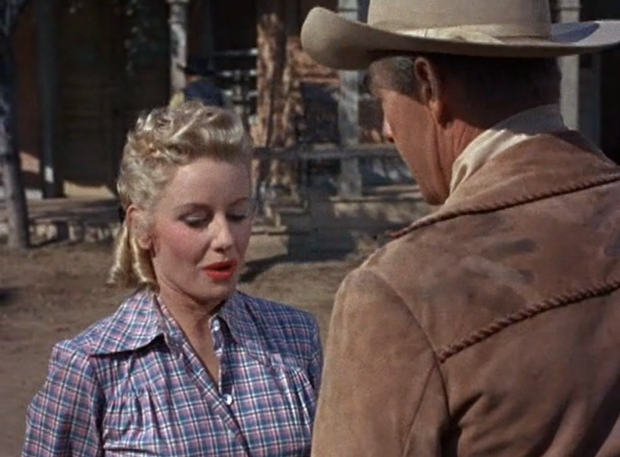
Fig. 56 - Handprints in "Carson City".
The woman with the print on the rear of her dress had rounded the bar and disappeared in the direction of what, on Closing Day, Dick had told Wendy was the path to the kitchen, leading her and Danny through there. Now, "Jeeves" leads Jack to the end of the bar, where we see between it and the large curtain two doors with a sign between identifying this as a toilet and powder room entrance. This would appear to be where the woman had gone who had caused the collision. As they move toward these doors, various surrounding people steal glances at them, and there's one older woman at a table near the door who catches the eye though she's a background presence. She stares with particular emphasis, her style different from the others as she has long hair that she is wearing down in a way not seen on any of the other women, perhaps having long hair about the length of the old woman whom Jack had found himself embracing in the bathroom. Seated with two much younger men and a younger woman, she intently focuses on Jack as he passes, and I do believe she is the older woman whom Jack had found himself embracing in Room 237.
If the young woman with the white feather and the red print on the bottom of her dress was the young woman in Room 237 (or intended to be a double of her), this would be significant as I do think the older woman who looks in Jack's direction is the woman who finds himself kissing, both women appearing coincident each other as the action moves into another bathroom.
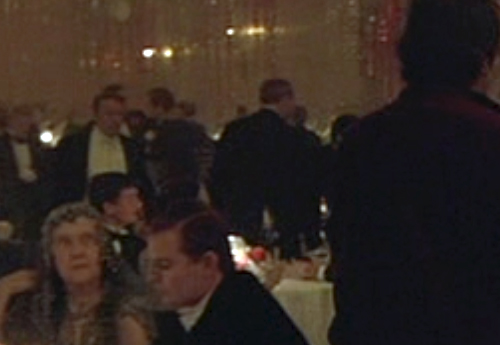
Fig. 57 - Blow up of the older woman staring at Jack.

Fig. 58 - The older woman who Jack had embraced in Room 237.
JACK: Awfully nice of you to say. Course I intend to change my jacket this evening before the fish and goose soiree.
GRADY: Very wise, sir. Very wise.
Jack and Grady enter through the right door into a little entrance foyer to the bathroom. We see on the wall a red wall hanging with a black and red open diamond pattern, very distinctive, which will be observed again later near an exit/entrance in the hotel that has yet to be seen. That later shot of the red diamond rug takes place when Jack exits the lodge in pursuit of Danny. We also see it again at the film's end, as a wall hanging to the left of the photographs off the lobby, but then the rug will be turned 90 degrees. and is vertical rather than horizontal.
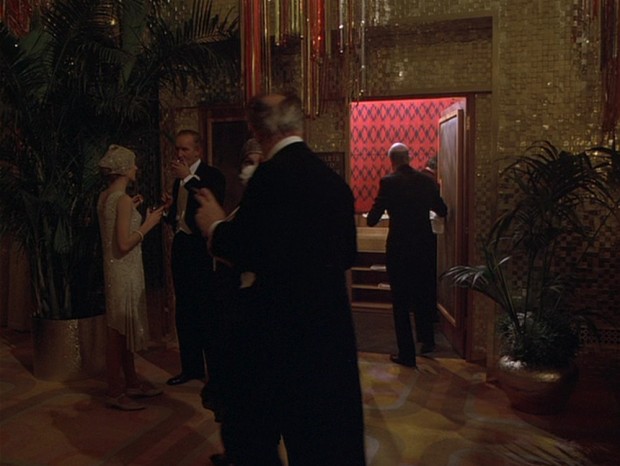
Fig. 59 - As they exit to the bathroom, we see the red diamond wall hanging.
HELL
THE RED BATHROOM - COMPARING THE GOLD ROOM AND RED BATHROOM TO THE LOBBY
JACK: Here, I'll just uh...
368 MS red bathroom. (1:25:26)
They enter a bright red bathroom as Jack says...
JACK: ...hold this for you there.
GRADY: Oh.
JACK: Jeevesick.
GRADY: Thank you, sir, thank you.
We hear applause outside, the song finishing.
When we saw Jack and Grady enter the little foyer to the toilets/powder room, Jack went right once inside as Grady stepped out of his way to the left. Now in shot 368 we've cut to Jack holding a 2nd door for Grady, then they pass through a third into the red bathroom. According to these turns, the bathroom would then actually cross back over the body of the bar. In the bathroom, Jack puts down his bourbon and Advocaat in the approximate location where it was spilled out in the Gold Room.
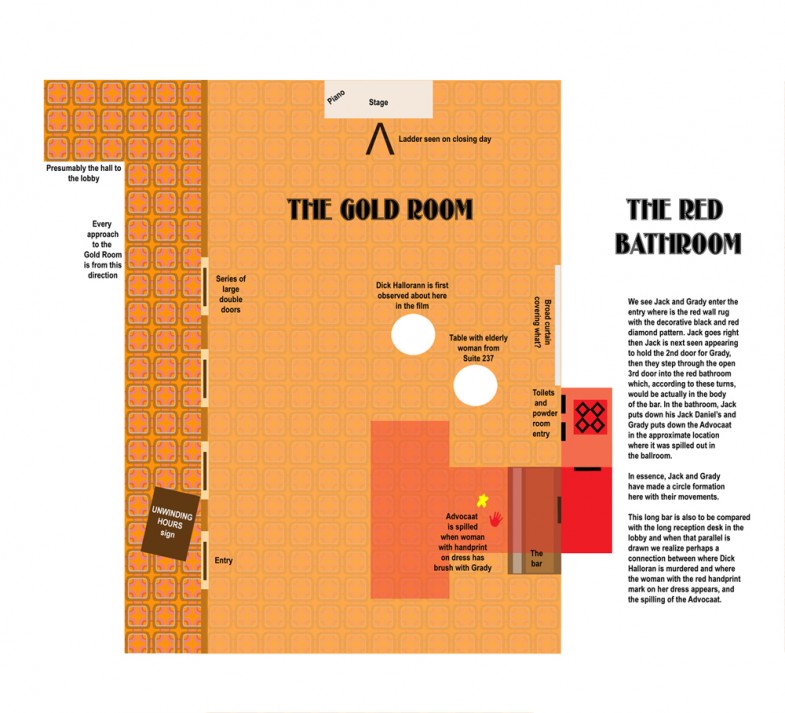
Fig. 60 - The relationship of the Gold Room to the red bathroom.
This long bar in the Gold Room is also to be compared with the long reception desk in the lobby, and when that parallel is drawn we realize that Dick Hallorann is killed in the area (though in the lobby) where the Advocaat was spilled in coincidence with the woman with the white feather headdress and the red design, that might call to mind a hand print, on her bottom colliding with Grady and knocking him into Jack. And it is also the same area where Jack places down that glass of Jack Daniel's and Advocaat in the red bathroom.
How I envisioned the layout of the red bathroom and the Gold Room is co-oberated by a photo from the set on The Overlook Hotel tumblr and which I am borrowing.
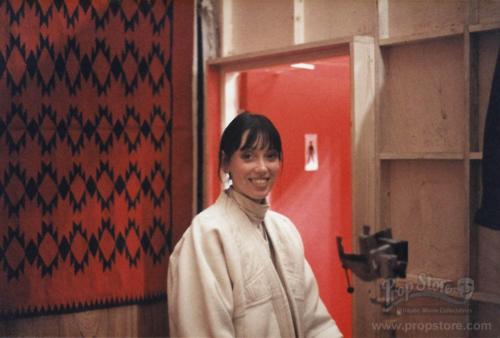
Fig. 61 - Photo of Shelley Duvall standing outside the red bathroom.
The entry is to the right instead of against the back wall. So they do enter right, then take another immediate right into the lavatory area, and are placed right back out in the Gold Room. Yet instead we are seeing the bathroom.
My guess was a good guess, but what happens in that entry foyer is yet another example of the blind right angle, 90 degree turn, just as I described with the foyer entrance to Room 237. We had missing, obscured information.
GRADY: Now, let's see if we can improve this with a little water, sir.
JACK: All right, I'll just set my bourbon and Advocaat down. Right there.
GRADY: Won't keep you a moment sir.
We have left Lloyd behind at the bar but his name is still present as this bathroom is said to be based on one Frank Lloyd Wright designed for a hotel in Phoenix.
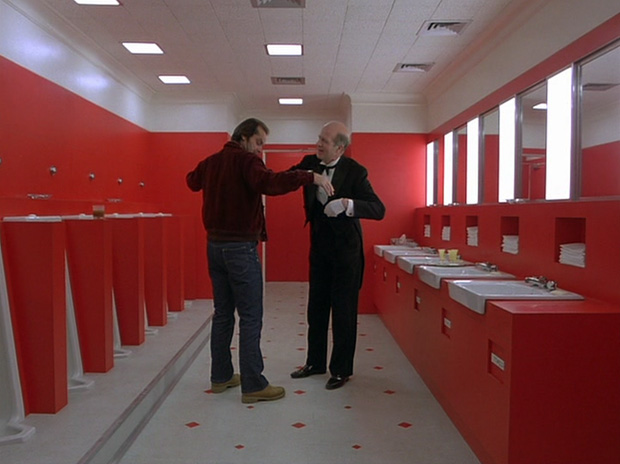
Fig. 62 - Jack assumes a cross-like pose.
An advocate is someone who is called upon as to advise, to counsel. Jeeves/Grady is about to give Jack counsel.
The advocaat is a Kubrick touch, not in the book. Danny's name in Hebrew means judge, also advocate.
As the waiter sponges off Jack in the bright red and white bathroom, Jack stands in a posture very like standard crucifixion images, his arms widespread (Christ is called an advocate, an intercessor) which fits in with the earlier Hanged Man/cross/redrum image.
The action here is rather confusing, Jack trying to get Grady to remember who he is, Grady denying he was ever a caretaker, having a different name than the Grady who killed his wife and two daughters, but having also had a wife and two daughters who it's intimated he had killed. Deja vu figured strongly in the bedroom scene when Wendy was serving Jack the eggs. I've written at length in the A Clockwork Orange analysis on the egg scene in Lolita during which Humbert Humbert quotes a poem by the "Divine Edgar", noting how he twists words so they return backwards. The poem is all about deja vu and being seemingly unable to avoid destiny which replays again and again. I'll quote a partial section of that before continuing on.
If we return to the "divine Edgar" and his poem "Ulalume" which Humbert had partially recited to Lolita, we see that psyche (soul, mind) is a prominent player, and thus perhaps Dr. Taylor as the psychiatrist. In Lolita, Humbert promised Lolita during the divine Edgar scene that he would never reveal any of her secrets, which is when she offered him the reward of the egg. Here, the psychiatrist (psyche) has a secret concerning Alex and his dreams she wishes not to divulge. In "Ulalume", the poem that Humbert had partly read to Lo, Poe's psyche attempts repeatedly to prevent him from following a path he will later discover leads to the tomb of his lost Ulalume. Along the way he spies the star of Astarte which his psyche mistrusts.
Astarte is a fertility goddess, her name coming from a word for "womb" (so I read). Her symbols include the sphinx, hinted at above with the lion.
The Duke of York pub scene occurred prior Alex's invasion of the Cat Woman's home.
So, in "Ulalume", which Kubrick has quoted in Lolita--and we find is obliquely referenced here and at Edgwarebury, where Alex attempts suicide--Poe's psyche attempts to keep him from taking a path which turns out to be one he had taken the previous year, of which he was unconscious, and thus he experiences deja vu and comes again on the tomb of Ulalume.
We find the same in The Shining, again connected with eggs, Wendy serving Jack a breakfast of eggs and as he eats it he recounts how when he'd arrived he'd experienced such deja vu he felt he knew what would be around every corner, and fell in love with it immediately. Then, later, with the Advocaat incident (Advocaat being made of eggs) he had a collision with the past and retiring to the bathroom with the waiter is goaded and "egged on" to come to no uncertain terms with the so-called rebelliousness of his wife and son.
The main crux of the matter here is that deja vu and repetition.
Alex, released from prison, had found himself accidentally visiting scenes from his former life. Deja vu.
We've then the same formula in The Shining of eggs/Edgar/edge experienced with deja vu and eventually a collision with the past. Why eggs? Kubrick is just carrying the theme from one film to the next. The eggs and deja vu in Lolita. Deja vu and Alex and eggs in "A Clockwork Orange".
The past repeating itself is the subject of the "Uncanny Tales" comic in Alex's prison cell, the one of the developing photo of the train running into a wagon on a track and the dialogue balloon of "Holy smoke! I've photographed something that happened a century ago!"
We've had a version of this with Alex meeting again the Irish bum, only this time he was abused, and his returning to HOME, though not recognizing it at first, just as he at first didn't recognize the bum. A cycling about into same territory though experience within it alters. My notes on Remembrance and Repetition in Kubrick's "The Shining" deal with this especially concerning Room 237.
The psychiatrist, Dr. Taylor, who appears to be the same waitress serving at the Duke of York pub, draws our attention again to Alex's cycling of experience, only here it involves not meeting the same person, being in the same place, but a doubled woman with whom Alex didn't appear to have any interaction the first time around, and appears here in an entirely different capacity as a different person. Our only information on her concerning the Duke of York pub was that she was wearing a red jumper, white shirt, and a style of wig that is recalled in the attire of Alex's mother when he returns home after his imprisonment, a style anticipated (though different) when his mother awakens him earlier in the film.
Memory and forgetfulness play a large part in the movie. When Alex meets again the Irish bum and then the writer, both times there is the initial time of non-recognition, then the awakening of one then the other. When Alex protests to his droogs, calling them to remember the old days, Dim says he doesn't recollect them though Georgie Boy says "enough" is remembered.
From the "A Clockwork Orange" analysis
In a way, we literally see deja vu in this bathroom via the repeated sinks and urinals, just as with any of the repetitive designs in the Overlook.
JACK: What do they call you around here, Jeevesey?
GRADY: Grady, sir. Delbert Grady.
369 MS Jack from behind Grady. (1:25:54) Jack stares.
JACK: Grady?
GRADY: Yes, sir?
JACK: Delbert Grady?
GRADY: That's right, sir.
JACK: Mr. Grady, haven't I seen you somewhere, before?
GRADY: Why, no, sir. I don't believe so.
Jack examines his own reflection in the mirror while speaking with him. Grady wets his napkin a second time and begins dabbing Jack's jacket again.
GRADY: It's coming off now, sir.
JACK: Mr. Grady, weren't you once the caretaker here?
GRADY: Why, no, sir. I don't believe so.
Grady says no--which in a sense is true as it was Charles Grady who was the caretaker in the 1970 incident, not in the 1920s.
JACK: You a married man, are ya, Mr. Grady?
GRADY: Yes, sir. I have a wife and two daughters, sir.
JACK: And where are they now.
GRADY: Oh, they're somewhere around. I'm not quite sure at the moment, sir.
Delbert Grady dismisses Jack's questions, which one could take as the obliviousness of some ghostly lost soul, but brings to mind for me the waiter in Remains of the Day who was so devoted to his employer that he had almost nothing left for his family. One's life was in service to the upper class.
Jack takes Grady's napkin from him.
GRADY: Mr. Grady, you were the caretaker here, I recognize ya. I saw your picture in the newspapers. You chopped your wife and daughter up into little bits and you blew your brains out.
Note that Jack said "daughter" not "daughters".
Jack tosses the napkin in the sink.
370 MS Grady from behind Jack. (1:27:42)
GRADY (staring, incomprehending): That's strange, sir. I don't have any recollection of that at all.
JACK: Mr. Grady you WERE the caretaker here.
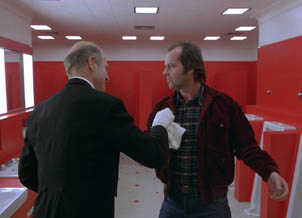 369 |
 370 |
371 MS Jack from behind Grady. (1:28:03)
GRADY (his tone changing, no longer submissive): I'm sorry to differ with you, sir. But you are the caretaker. You've always been the caretaker. I should know, sir, I've always been here.

Fig. 63 - Jack speaking to himself in the mirror (to Grady).
372 MCU Jack. (1:28:37)
Jack stares, a bizarre grimace smile finally crossing his face.
373 MCU Grady (1:28:45)
Grady stares back.
GRADY: Did you know, Mr. Torrance, that your son is attempting to bring an outside party into this situation. Did you know that?
374 MCU Jack. (1:29:03)
Jack shakes his head no as another song ends and we hear applause.
JACK: No.
375 MCU Grady (1:29:09)
GRADY: He is, Mr. Torrance.
376 MCU Jack. (1:29:12)
JACK: Who?
And another song begins.
377 MCU Grady (1:29:15) Grady replies in shocking language.
GRADY: A nigger.
378 MCU Jack. (1:29:19) A stunned reaction shot from Jack.
JACK: A nigger?
379 MCU Grady (1:29:25)
GRADY: A nigger cook.
380 MCU Jack. (1:29:32)
JACK: How?
381 MCU Grady (1:29:37)
GRADY: Your son has a very great talent. I don't think you're aware how great it is, but he's attempting to use that very talent against your will.
382 MCU Jack. (1:29:56)
JACK: Well, he is a very willful boy.
383 MCU Grady (1:30:12)
GRADY: Indeed he is, Mr. Torrance. A very willful boy. A rather naughty boy, if I may be so bold, sir.
384 MCU Jack. (1:30:27)
Jack glances to the side warily, then seems to come up with a retort that pleases him.
JACK: It's his mother, she interferes.
He backs off slightly, as if wondering what might be the answer to that, uncertain.
385 MCU Grady (1:30:42)
GRADY: Perhaps they need a good talking to. If you don't mind my saying so, perhaps a bit more.
386 MCU Jack. (1:30:58)
GRADY (off-screen): My girls, sir, they didn't care for the Overlook at first. One of them actually stole a pack of matches...
387 MCU Grady (1:31:10)
GRADY: ...and tried to burn it down, but I corrected them, sir, and when my wife tried to prevent me from doing my duty, I corrected her.
388 MCU Jack. (1:31:29)
Jack stares and finally gives a little laugh.
389 MCU Grady (1:31:34)
Grady stares back.
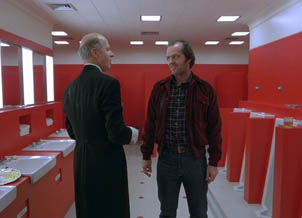 371 |
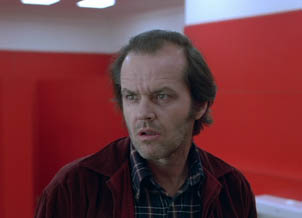 372 |
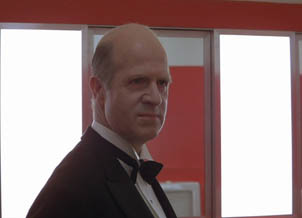 373 |
 374 |
 375 |
 376 |
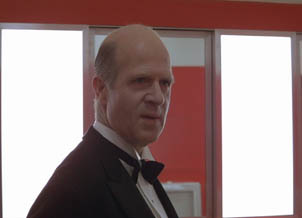 377 |
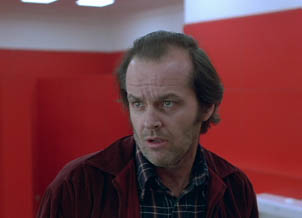 378 |
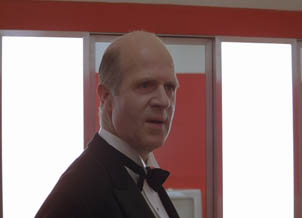 379 |
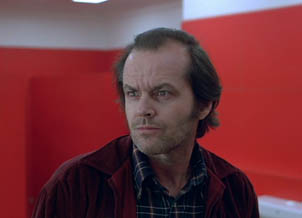 380 |
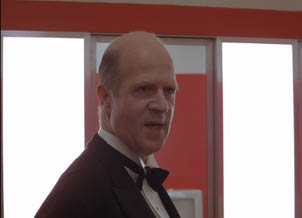 381 |
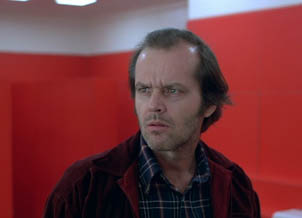 382 |
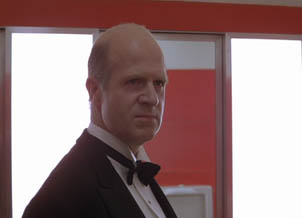 383 |
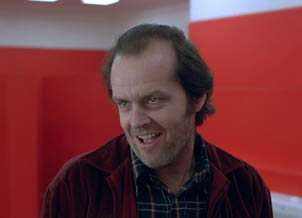 384 |
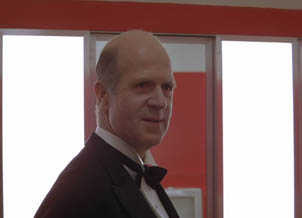 385 |
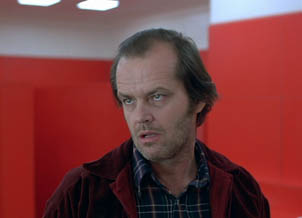 386 |
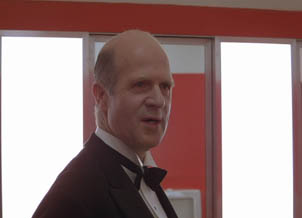 387 |
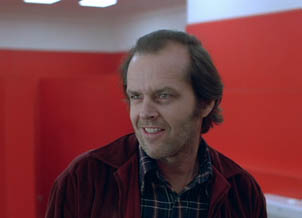 378 |
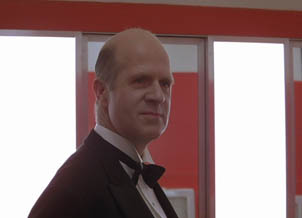 389 |
|
The dialogue is an awkward one with long pauses on Jack's part, contorted expressions, and responses that seem out of accord with Grady at times, but then Jack is playing to both the mirror and Grady, because he is speaking to both--to the actor playing Grady and to himself in the mirror.
Jack's "white man's burden", the white supremacy, the racism, the misogyny, the desperate need to keep the system in place and everyone in line, has caught up fully with Jack, and openly expressed.
ABOUT THAT FRANK LLOYD WRIGHT INSPIRED BATHROOM
The bathroom was said by Kubrick to have been inspired by one designed by Wright at a hotel in Phoenix. I've never seen a photo of that bathroom, however, and one would imagine that with the interest accorded by this film, and the ease of transmission of information with the internet, that if a photo of the bathroom existed we'd now have it. Would one exist in the Kubrick archives? Where is it?
Though Kubrick, in an interview, gave Wright as having designed a hotel in Phoenix, the Biltmore, that's not quite the case. Instead, Wright consulted on the hotel which was designed by Albert Chase McArthur. Still, with Taliesin West being in Phoenix/Scottsdale (beautiful place), and Wright consulting, and with the influence of Wright, then we have a Wright that is not a Wright, which rather fits in with identity confusions in Kubrick's films, which he also has in Eyes Wide Shut with a painting by his wife that is done after Van Gogh, not by Van Gogh but looking like Van Gogh, and a tub of "I Can't Believe it's not Butter" on the Harford breakfast table.
What's more of interest to me is the association with the Biltmore (2400 E. Missouri Avenue in Phoenix) bringing in a Bowman, John McEntee Bowman (died 1931) who was the founding president of Bowman-Biltmore Hotels Corp. And that name, Bowman (harking back to Dave Bowman of "2001") being associated here with a hotel in Phoenix, a city named for a bird that perpetually regenerates itself in flame. Dave Bowman, is virtually reborn in a highly evolved state at the end of 2001. The Bowman name also presides over the maze of the street set in Eyes Wide Shut, observed in an ad above a hardware store.
I propose in my 2001 analysis that we do indeed have Frank Poole, after a fashion, surviving in his "twin", Dave Bowman. Was Kubrick playing with bringing in both Frank and Dave with the conjunction of John Bowman and Frank L. Wright? I'm not really prepared to go there but this could be or it could be a coincidence.
The bathroom is a bloody shock of red, the interior design of which has zero to do with the hotel. Which is why it is shocking. There is nothing previously seen in the hotel that prepares us for it. And it is horrifying-shocking in its redness seeming to psychically broadcast gore. Imagine story boards for this film, and then suddenly there is this red minimalist bathroom. "Well, it's based on a Frank Lloyd Wright bathroom in Arizona." Did we not just see the wood-paneled entry, with its black diamond on red rug? How did we go from the gaudy Gold Room to rustic wood-paneled entry foyer to this sleek bathroom that 50 years later is still ultra-modern and which seems to have more to do with the startling red opening credits to Clockwork Orange?
This is the bloody bathroom from hell (or interior design heaven) that perpetually repeats into infinity via its urinals and sinks etc. And because it perpetually repeats elements into infinity it also gives a distinct claustrophobic feel, almost like a prison. This is Jack locked in perpetual deja vu.
As far as inspired by Wright goes, the red seems to have more to do with Wright's Taliesin logo than anything else I've seen.
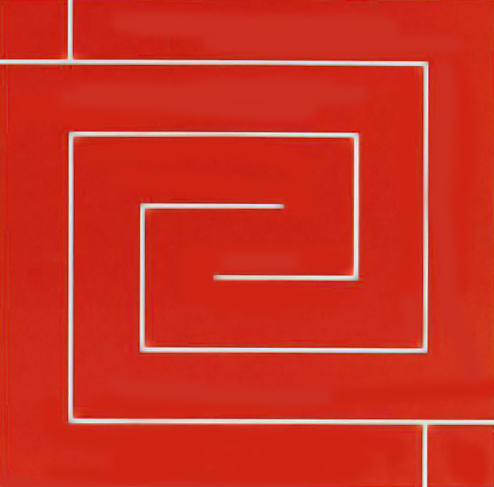
That logo is also a stylized labyrinth.
Why bring in Wright's name? There is the Biltmore-Bowman association. And, as I point out in the opening analysis we have the Overlook on the Continental Divide. East meets west. Wright had both Taliesin East and Taliesin West. Kubrick follows this pattern repeatedly in his films, the dividing line becoming the "between" space, for instance, in which the Monolith is situated in 2001.
A variation of The Song of Taliesin was used in Kubrick's film Fear and Desire, spoken by Private Sidney when he had supposedly gone mad, which led to his shooting a female prisoner. He also proclaimed a nearby river flowed with blood rather than water. This certainly links with the flood of blood that will flow from the Overlook's elevator.
Famously, Taliesin East was the site of a horrible mass murder by fire and ax. KDK12 mentions this on his Tumblr and proposes there might be an association through this tragedy. On August 15, 1914, Julian Carlton, butler and handyman, hatcheted Mamah Borthwick (Wright's lover), her son John, 12; and her daughter Martha, 9, while they were eating. He then set fire to a wing of Taliesin in which other residents were dining, bolted the area, then stood outside and axed those who tried to escape. Those killed were Ernest Weston, 13; Emil Brodelle, 26; David Lindblom, 38; and Thomas Brunker, 68.
Carlton didn't try to escape. He drank acid immediately after and died two months later. He never gave a reason, apparently, for what he did. Were there racial tensions? Was it in retribution for Martha firing Julian and his wife, who served as cook?
Did you know Wright was an anti-Semite? Wright was, yes, a visionary, and I love his architecture and design, but he was also something of a tyrant who exercised extreme control over people, and got a lot of work done for him for free that way.
It is now, in the film, in this bathroom inspired by Wright, that we have racism rear its ugly head in the dialogue.
I think it's very possible that Kubrick brought in Wright partly due the fire/axe murders at Taliesin by a handyman/butler (caretaker) whose wife was the cook. Perhaps also his anti-semitism. Perhaps also because of Taliesin.
THE GOLD ROOM AND THE ARIZONA BILTMORE
Continuing with the Arizona Biltmore discussion, KDK12 compares the Gold Room with the Gold Room of the Arizona Biltmore and it really does bear examining if there is an influence.
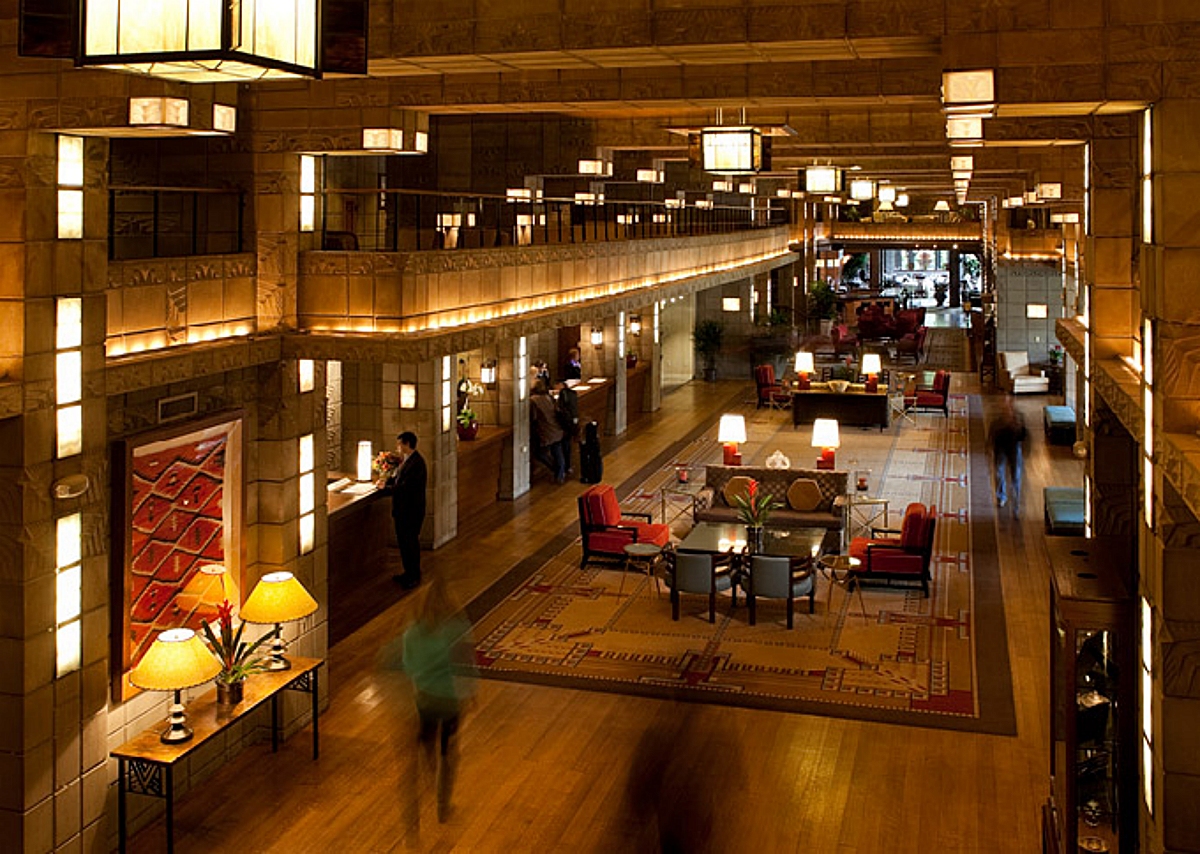
The Arizona Biltmore lobby. Photo source: Arizona Biltmore.
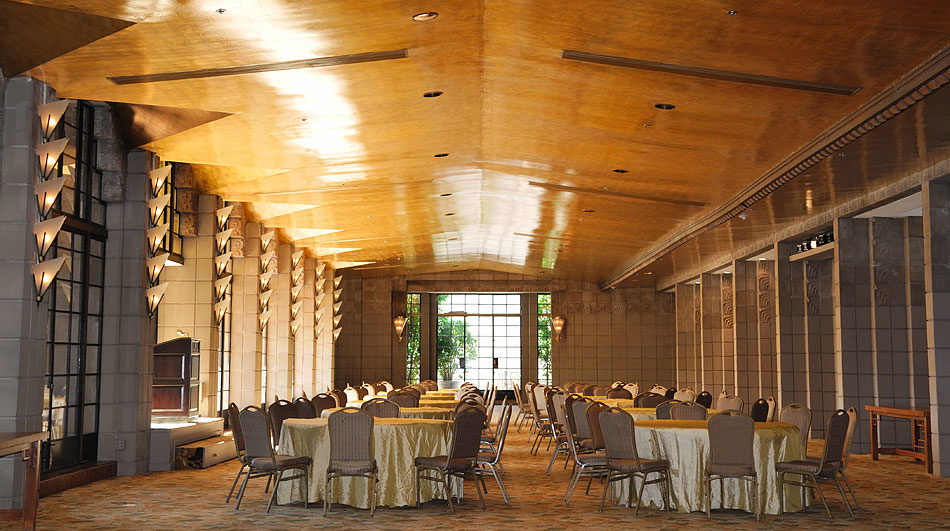
Arizona Biltmore Gold Room. Photo source: Trailergypsies website.
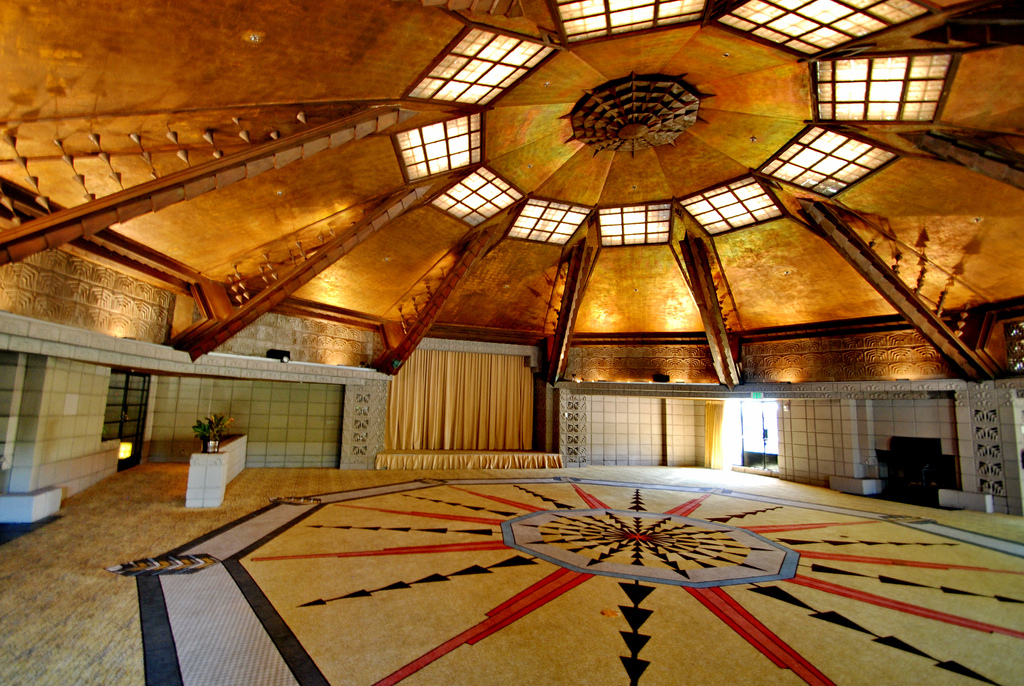
Arizona Biltmore Aztec Room. Photo source: Advantage Travel and Events website.
Y'think this is where maybe Kubrick got his idea to have the Gold Room painstakingly plated with little goldleafed tiles?
Maybe.
I've not ever visited the Arizona Biltmore, but we find that gold leaf was not only applied to the ceiling of its own Gold Room, but it is in other parts of the hotel as well: in the lobby, where we have lighting panels reminiscent of those at the bar in the Overlook Gold Room (as well as the bathroom), and in the Aztec Room with its ponderous wheel that reminds me of the magnificent and massive wheel design in the Timberline's entry (see the Interview section for discussion).
Amazing, that Aztec Room.
Speaking of twins, the Arizona Biltmore Gold Room is also the site of a large mural by Edith Hamlin of The Turquoise Goddess and Warrior Twins.
THE TWO GRADYS, CHARLES AND DELBERT
To address the matter of the two Gradys, Delbert and Charles. There is no Charles Grady in the book, no confusion of the name there, so what Kubrick has done, having Grady as both Charles and Delbert, calls attention to the name change, and by calling attention to the name and its change, invites one to look for a meaning in this, and to perhaps consider the meaning of some of the other names as well.
Significance in name changes can be found in the story of Esau and Jacob, Kubrick having brought in the story through his use of is Krzysztof Penderecki's "The Awakening of Jacob" first when Danny talks to Tony in his bathroom, and then with Jack's nightmare.
In stories around the world one has the ancient city dweller and the more "natural" man of the field who is one with the animals. In the myth of Gilgamesh he is a semi-divine hero who befriends the wild man Enkidu, trapping him into civilization with a temple prostitute who socializes him. But, Enkidu has actually been sent by the gods because the people have complained about Gilgamesh's will run amuck, he lording his power over them, and Enkidu is intended to restrain him, which he does. When Enkidu and Gilgamesh kill the Bull of Heaven, the gods determine Enkidu must be punished. Enkidu dies and descends to the Underworld. Hoping to avoid Enkidu's fate, Gilgamesh travels to Utnapishtim to visit the Babylonian version of Noah and his wife, the only humans who survived the Great Flood and were granted immortality. Gilgamesh is told the story of the flood and given an opportunity for eternal life but neglectfully treats the plant which would supply him immortality so that it is instead consumed by a serpent which sheds its skin and is reborn.
The story of Esau and Jacob seems a variation on that in certain respects. As discussed in the Interview section, Jacob represents the inner, mystic life, while Esau, the hunter, represents that of the physical, just as we have with the above stories the split between the civilized man and the wild man, the civilized man representing also the interior, mystic life. And just as we have a rebirth theme in the story of Gilgamesh and Enkidu, so do we find a rebirth had with Jacob.
Not only did Jacob wrestle with his twin Esau in the womb and struggle with him throughout life, he would eventually wrestle with a mysterious being (often taken as angelic) and be lamed. He died in Egypt, according to Bible lore, his son Joseph being the one who took the Hebrews into Egypt during a time of famine. Thinking of the story in relation to the film, one needs to look upon it not literally, or to do with nations, but dealing with archetypes, human nature and attempts to relate that nature to the cosmos at large. Rather than two individuals they are archetypes, Esau and Jacob representing dualities that form a whole. In the story of Jacob and Esau, Esau is the hunter, and Jacob is the supplanter, his name signifying a catching by the heel. Jacob is supposed to be the good guy, but his actions can be pretty loathsome. Which happens in many biblical tales. People do loathsome things but because they were said to be communing with God and doing that God's will (at least in other instances), they're not reviled. Instead they are heroes and counted as righteous.
Esau, as the hunter, is in one story given as exhausted to the point of death and sells his birthright to the tent-dwelling (softer) Jacob for sake of a bowl of red lentil soup that Jacob had cooked, for which reason Esau acquired the name Edom, meaning red. So, taking advantage of Esau's hunger, Jacob acquires the birthright, but rather than he being disdained, Esau is instead historically disdained for selling the birthright in the first place. Eventually, disguising himself as Esau, putting on animal skins that make him seem as hairy as Esau, Jacob gained Esau's inheritance from their father, the blessing that had been reserved for him as the first-born.
Jacob (Jack is a variant of Jacob) flees Esau's wrath upon receiving his first-born inheritance through trickery, and during his flight he had his dream of the heavenly ladder. After a long cooling off period, when Jacob later returned to his home, he spent a night wrestling with a being, and the being, still wrestling with him at daybreak, bestowed on him a new name but also lamed him. The idea of the wrestling with the angel has been inferred in the story, but it is also posited that Jacob was wrestling with either Esau's guardian angel or instead his own yetzer ha-ra or evil inclination.
And Jacob was left alone; and there wrestled a man with him until the breaking of the day. And when he saw that he prevailed not against him, he touched the hollow of his thigh; and the hollow of Jacob's thigh was out of joint, as he wrestled with him.
Wrestled is ABQ, "to bedust", to wrestle, a primitive root meaning perhaps to float away (as a vapor), but also takes the form of another ABQ meaning expressly dust or powder. The Hebrew word for "touched" here is "naga'", and has primarily violent meanings, such as to smite, punish, destroy, defeat, but is also the idea of to "lay the hand upon (for any purpose; euphem., to lie with a woman)". The "hollow" of the thigh is KPh, which means the hollow hand or palm, from KPhPhH, which means to bow one's self down.
And Jacob asked, and said, Tell, I pray thee, thy name. And he said, Wherefore dost thou ask after my name? And he blessed him there. And Jacob called the name of the place Peniel: for I have seen God face to face, and my life is preserved.
"Tell" me here is peculiar as it is nawgad, meaning to manifest, announce, but also to stand boldly opposite of.
There are different versions of the story of Jacob and Esau, based on various interpretations of the text but also on psychological readings. The Sunday School Christian version is the one with which most will be familiar, and likely then a surprise that there are so many alternative views on it, many of which would seem utterly alien.
One reading of the text is that Jacob never died. He became immortal, or is reincarnated in every generation--I guess somewhat like ZKR, ZKRI, the kind of remembrance that is a real manifestation rather than a simple reflecting on the past.
What most strikes me is the ages old idea that it is impossible to see the face of god and live, and yet Jacob states that he has seen and his life has been preserved. It would seem that the preservation would have to do with the change of name. After all, to go under a new name would be to escape judgment for past deeds, not too novel an idea. And we have already in Jacob an individual who masked himself as his brother in order to receive his blessing. The name change would seem to be another expression of a reborn, alternate identity.
If I take the trouble to go into this, it's because Kubrick has connected the story with Jacob and Esau.
In Carson City (the movie on the television in the Torrance apartment during the Interview section), we've again a story of two brothers struggling against each other. There's a curious similarity between Carson City and The Shining. After the woman with the red print design on the back of her dress, similar to a hand print, passes by Jack in the Gold Room, causing the collision, Jack pats Grady's back leaving the advocaat hand-print on the back of his jacket. That hand print is in view for a good deal of the bathroom scene. In Carson City a woman hugs Silent Jeff, on their first meeting after a long while, leaving black and white ink and powder hand-prints on his back, a minor and insignificant joke. But it stands out when you watch the film with knowledge of Kubrick having used a portion of that movie leading in to Danny's first shining of the hotel, and knowing also of the actions in the Gold Room. In King's book, instead of the hand-print, Grady had instead brushed away an invisible spot of dirt on his own lapel, so Kubrick has taken this and magnified and expanded on it with Jack's intentionally placing a hand print on him. I've wondered if, for Kubrick, this links up with Jacob's wrestling match, as does the name change.
Jack has asked Grady what they call him there, and Grady has responded with the name Delbert, which was King's name for Grady but isn't the name by which Jack knows him, it isn't the name Kubrick has given him, Charles. Delbert insists he remembers nothing about the horrors Jack accuses him of, but only a moment later he relates how he had "corrected" his daughters as well as his own interfering wife and encourages Jack to do the same with his family. Charles Grady and Delbert Grady are one person yet separate, by virtue of the change in name, which also could be looked upon as masking him. He relates to Jack in that Grady is the caretaker but he says that Jack has always been the caretaker. Perhaps one can look upon it as the spirit of the caretaker that has always been present in Jack and which is being awakened.
We have perhaps a version of the story of Jacob's wrestling, which can be seen in Kubrick's sign that this is the door to the toilet and powder room. Powder room is a euphemism for toilet, so why include it. (Note March 2013. An individual wrote to ask about the use of the word powder room for the bathroom, and looking it up I found its first use wasn't even until 1941.) Perhaps there's a a possibility Kubrick has this identified as the powder room due a sort of wrestling that occurs here with...himself. Though we see that self as Grady. This powder association is one I'm not tied to. A passing thought that I keep around in case I find something else that shores it up.
DANNY'S NOT THERE
390 MS Wendy. (1:31:37)
Back in their suite, in the sitting room, Wendy talks to herself, the wind howling outside.
WENDY: We have the snowcat. If the weather breaks we might just be able to get down the mountain.
The heartbeat begins again.
WENDY: And uh, I could call the forest rangers first. And then tell them that we're coming so that they can start searching for us in case we didn't make it.
We notice a curious mark or hole in the center of the sitting room's rug. Perhaps a burn spot? Grady has just told the story of a daughter attempting to burn down the Overlook, and this hole in the rug I don't seem to locate earlier in the film, another unfolding.

Fig. 64 - The burned hole in the carpet.
The lamp casts light on the walls in the shape of two opposing birds. We had the same in shot 324 in Suite 237 as Jack was backing through the living room away from the old woman.

Fig. 25 - Jack backs down the stairs, horrified. We see the hall lit beyond.
WENDY: If Jack won't come with us, we'll, I'll just have to tell him that we're going by ourselves. That's all there is to it.
We hear sounds from the opening section that had seemed eerie and bird-like.
If we compare this version of the living room with what we'd observed before Jack stormed out, Wendy's been supposedly doing some redecorating, including getting another radiant heater. Previous views showed the radiant heater was situated by the doorway between the bedroom and sitting room and was not as wide. Now, it is instead under the window and longer. (I've lived with radiant heaters in a number of places and never have I seen more than one radiant heater in a room. Never. Ever.) Also, there had been no chair beside that doorway previously, only a small bench or table. Instead there is now an chair. Kubrick gives us ample opportunity to note these changes as he's followed Wendy walking back and forth and back and forth. The shift of the radiant heater is another one of those 90 degree turns.
Though this room has the radiator, we had also seen the vent for forced air near the entry door.
Wendy hears Danny yelling.
DANNY: Redrum, redrum, redrum, redrum.
She goes to his bedroom, still holding the cigarette she's been smoking, Kubrick cuts away as she opens the door.
391 MS Wendy entering Danny's room. (1:32:31)
Wendy enters Danny's room and is seen to be no longer holding her cigarette. He continues crying out.
DANNY: Redrum!
WENDY: Danny?
DANNY: Redrum! Redrum! Redrum!
She seats herself on his bed beside him.
WENDY: Danny, what's the matter, honey?
DANNY: Redrum!
WENDY: You having a bad dream?
392 MCU Danny from behind Wendy. (1:32:44)
WENDY: Danny? Hon?
He turns his eyes to her. Tony replies.
TONY: Danny's not here, Mrs. Torrance.
Her watch may read 9:30 or 10:30, it's difficult to tell. Perhaps 9:30.
393 MCU Wendy from behind Danny. (1:33:02)
WENDY: Come on, hon, wake up. You just had a bad dream. Everything's okay.
Just as she had told Jack everything was okay, but everything is not okay.
394 MCU Danny from behind Wendy. (1:33:18)
TONY: Danny can't wake up, Mrs. Torrance.
395 MCU Wendy from behind Danny. (1:33:26)
WENDY: Danny, wake up. Come on, right now!
396 MCU Danny from behind Wendy. (1:33:40)
TONY: Danny's gone away, Mrs. Torrance.
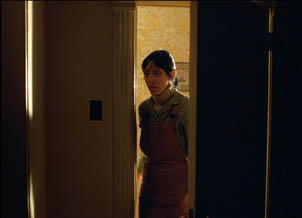 391 |
|
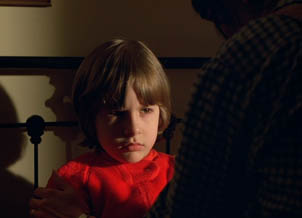 392 |
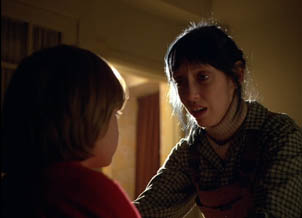 393 |
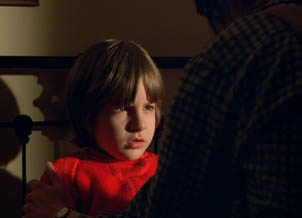 394 |
 395 |
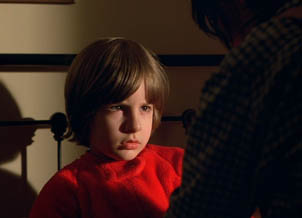 396 |
|
397 MCU Wendy from behind Danny. (1:33:50)
WENDY (clasping Danny to her): Danny.
With this shot, Kubrick introduces yet a third light source into the small hallway. In the beginning there had been the single one hanging from the ceiling after the steps. When Jack returned from Room 237, another light source was observed, introduced hanging just before the apartment's entry. Now, we have a third light source just outside Danny's door or there has been a shift in position of a lamp.

Fig. 65a - Wendy clasps Danny to her as Jack goes to the office.
JACK UNPLUGS
DISABLING OF THE TWO-WAY RADIO - YET ANOTHER FACADE OF THE LODGE
398 MS Jack in lobby. (1:33:56 begin crossfade to the lobby, crossfade ending at 1:33:59.)
Crossfade to Jack wandering through the lobby, and we see now a gold clock above the reception desk reads 11:45. We hear the forest service calling.
FOREST RANGER: KDK1 calling KDK12, KDK1 calling KDK12. Are you receiving me? This is KDK1 calling KDK12. KDK1 calling KDK12, do you read me?
Jack has entered the secretarial office and cut on the light.
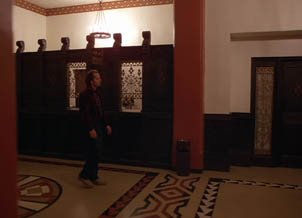 398 |
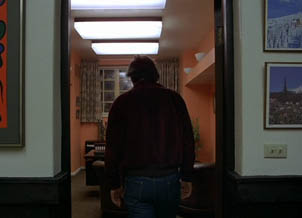 399 |
399 MS Jack. (1:34:20)
Jack enters the office and goes to the radio. Again, we hear the forest service.
FOREST RANGER: This is KDK1 calling KDK12. KDK1 calling KDK 12. Are you receiving me?
400 MS Jack from the side. (1:34:32)
FOREST RANGER: This is KDK1 calling KDK12. KDK1 calling KDK 12. Do you read me?
We see to the left side of the radio an old picture of the lodge in which there is a silhouette of an individual that is somehow striking, a rather ghostly presence. Most of the photos in the lodge are straight-forward photos of meetings, but then there are a few others that instead show ambiguous, shadowy presences. In this photo, we see the far west wing of the lodge looking pretty much as it does with the exterior shots of the lodge at Mt. Hood, but the central portion seems to be different.
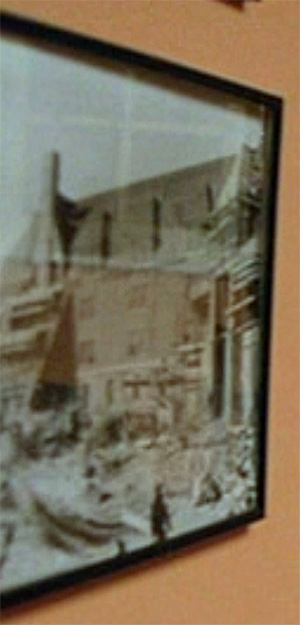
Fig. 66 - Photo of an old facade of the Overlook.
Compare with the opening day aerial.
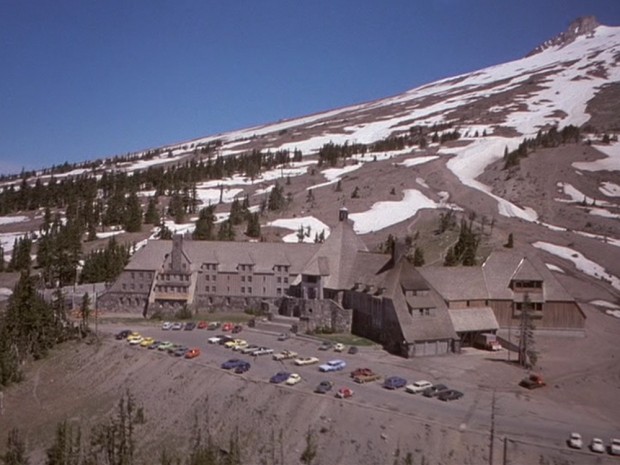
Fig. 67 - The Overlook as it appeared in the film's opening. The main entry seems different from the old photo.
Compare the above purportedly old photo of the Overlook in figure 66 also with an old photo of the Timberline, one taken when it was opened in 1937.
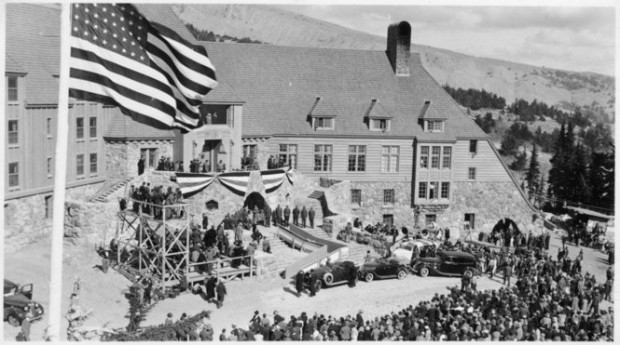
Fig. 68 - The Timberline as it appeared in 1937
Is it only that the entry area is possibly still under construction in image 66? It seems so different. What is certainly lacking is the great stone facade out front. Perhaps it hadn't been added on yet. But I have the feeling the two human figures are not native to the photo and have been added in.
The figures are very much like the dark silhouette observed in the image in the entry to Room 237. That figure had polymorphed into a switch on the boiler.

The silhouette in the painting at the entry of Room 237.
There is another photo above but I can't begin to get a fix on what it is.
 Fig. 69 - What the hell is this?
Fig. 69 - What the hell is this?
Whatever one thinks that photo is, at first glimpse, it is not. We're given the impression of a train. It is not. It's like four dome-head aliens looking over the scene in the background. I haven't a clue what they actually are. On the left we see something resembling pipes.
Jack takes apart the radio and lifts off the top.

Fig. 70 - Jack dismantles the radio.
FOREST RANGER: This is KDK1 calling KDK12. KDK1 calling KDK12. Are you receiv...
401 Jack pulls out a relay and briefly clutches it tight. I had originally not known what this was and a reader, Michael Thomas, wrote to inform me these were relays, switching devices.
 Fig. 71 - Jack clutches the relay.
Fig. 71 - Jack clutches the relay.
He pulls out a second. A third. One is reminded of HAL being shut down, or of CRM-114, communication impossible now, the lodge entirely cut off.
FIRE SERVICE
402 MS Dick in Miami sun room. (1:35:03)
Cut back to Dick calling a forest ranger on his red phone.
NIGHT FOREST RANGER: Good evening, fire service.
DICK: Hello, this is Dick Hallorann again. I called a while ago about the folks at the Overlook Hotel?
403 MS Ranger. (1:35:15)
NIGHT FOREST RANGER: Oh, yeah, we tried to contact them several times by radio but they didn't answer.
Another ranger walks by.
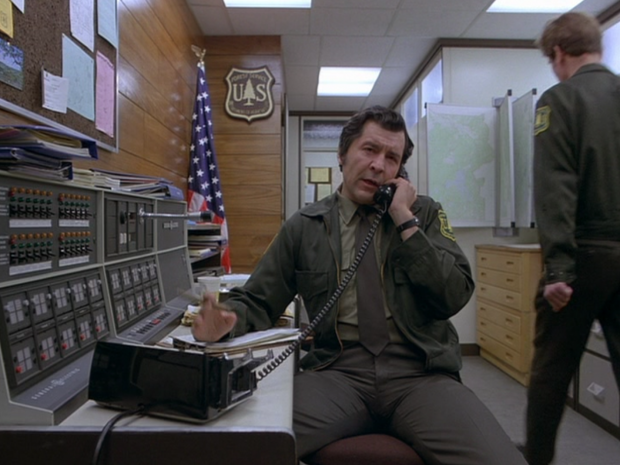
Fig. 72 - The night forest ranger smoking a cigar.
NIGHT FOREST RANGER: Now maybe they've got their radio turned off or they're in a place where they can't hear it. If you'd like me to I'd be glad to try them again later on.
The kind of white crumb that was between the ranger's legs when Dick previously called is no longer there. What we perhaps have is a pun going on here. When the radio is disconnected, Jack is shown clutching the relays, they are held tight. Then here the "crumb" is gone and the other ranger is walking past with his fist clutched tight, a faceless ranger who disappears to the left in the hall beyond. I wonder if it's a possible play on words, on CRM-114. The "crumb" with its silent "b" is CRM. This may seem absurd to consider it is possibly a pun. Still, I consider it.
Also, the pencil has been replaced with a cigar. in Dr. Strangelove, General Jack D. Ripper smoked cigars.
As soon as Danny enters the maze in the final section, Jack's right hand releases the axe and is from then on a fist that he keeps before his jacket, as if he's clutching his jacket shut against the cold. However, the thing is the fist. He never releases the fist. Kubrick shows Danny fall and he puts out his hands naturally to brace himself against the fall. When Jack falls, he doesn't release that fist to brace himself against the fall. He takes the weight of the fall on his shoulder. He refuses to release that fist.
404 MS Dick in Miami sun room. (1:35:31)
DICK (disheartened, worried): Oh, that's very nice of you. I'll call back later. Bye.
He hangs up the phone, the heartbeat continuing.
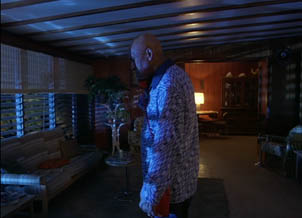 402 |
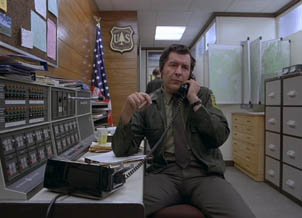 403 |
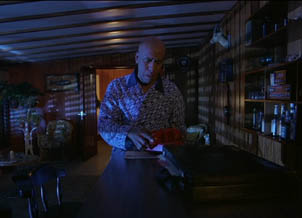 404 |
|
In review, what has Kubrick given us in this section?
Terrifying rotting old lady. Psycho made us all afraid of what was outside the bathtub/shower when we're in it. The Shining has made us all afraid of what's behind the shower curtain when we're outside of it. No one will ever leave their shower curtain closed again, not even partly. When you're brushing your teeth or using the john, if your eye strays to the shower curtain and it's closed then your heart will beat a little faster wondering what that hint of a shadow is behind it. It's a wonder we haven't all given up on bathrooms.
What's the teaser candy bait?
Face it, there is nothing that isn't teaser candy bait in this film.
What's the distraction?
That this has anything to do with Stephen King's vision.
What's the Food for Thought?
How any certainly in what we believe we are seeing keeps being blown apart by various perspectives.
What's the deep infrastructure?
The tie-in of the bathroom of Room 237 with the central portion of the maze.
tl;dr version?
Jack goes on one hell of a dry drunk. CRM of CRM-114 is tied to the radio being disconnected.
First placed online 2007-2009 in loose form. Added all shots 2012. Approx 21,250 words or 43 single-spaced pages. A 163 minute read at 130 wpm.
NEXT: 8 AM
Return to Table of Contents for "The Shining" analysis
Link to the main TOC page for all the analyses

